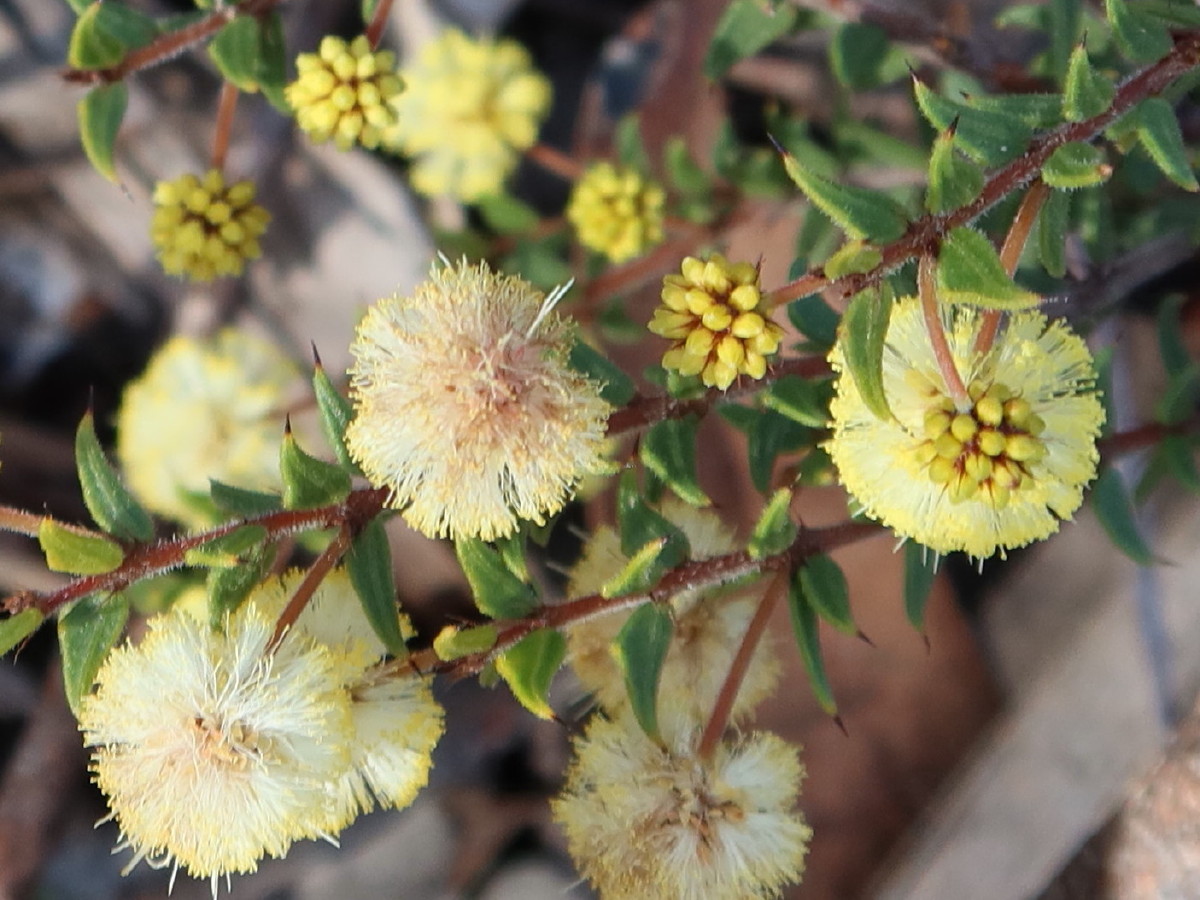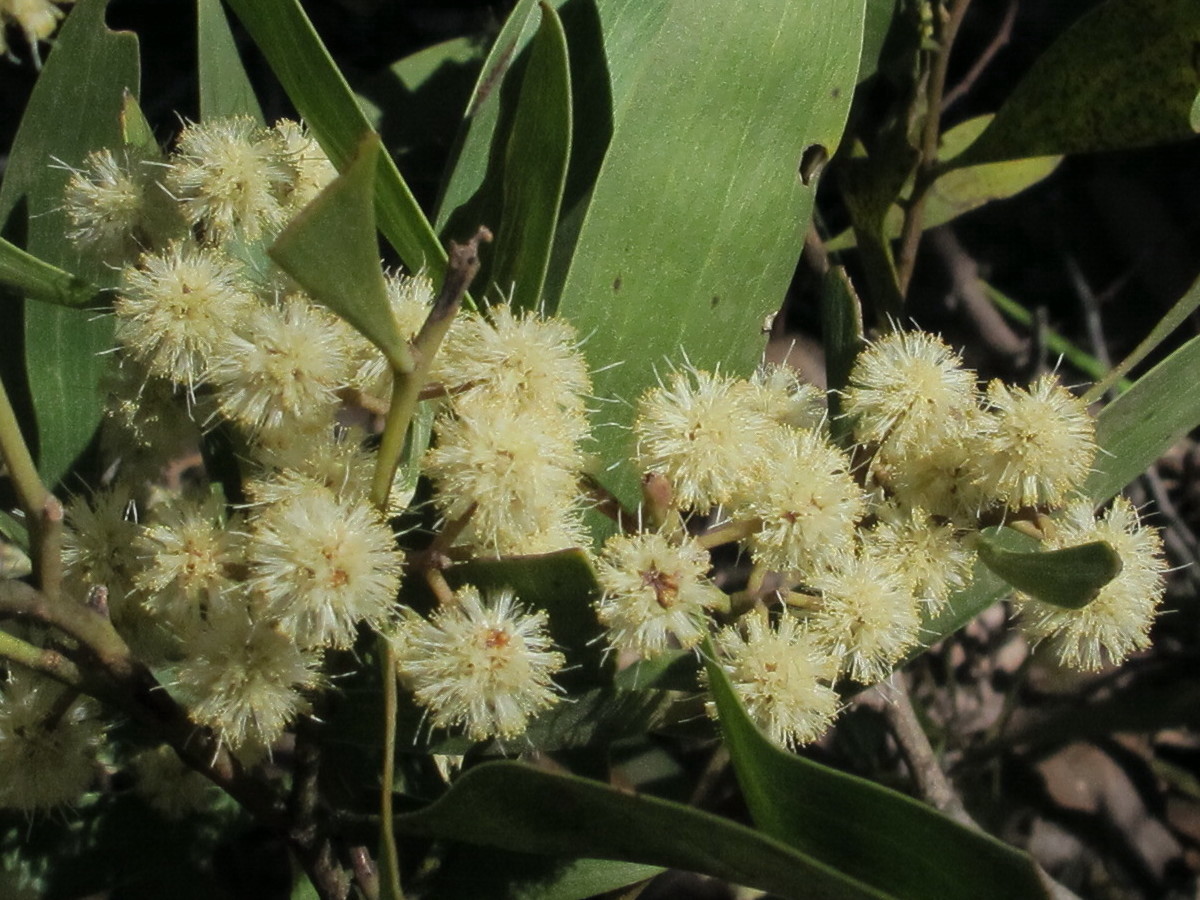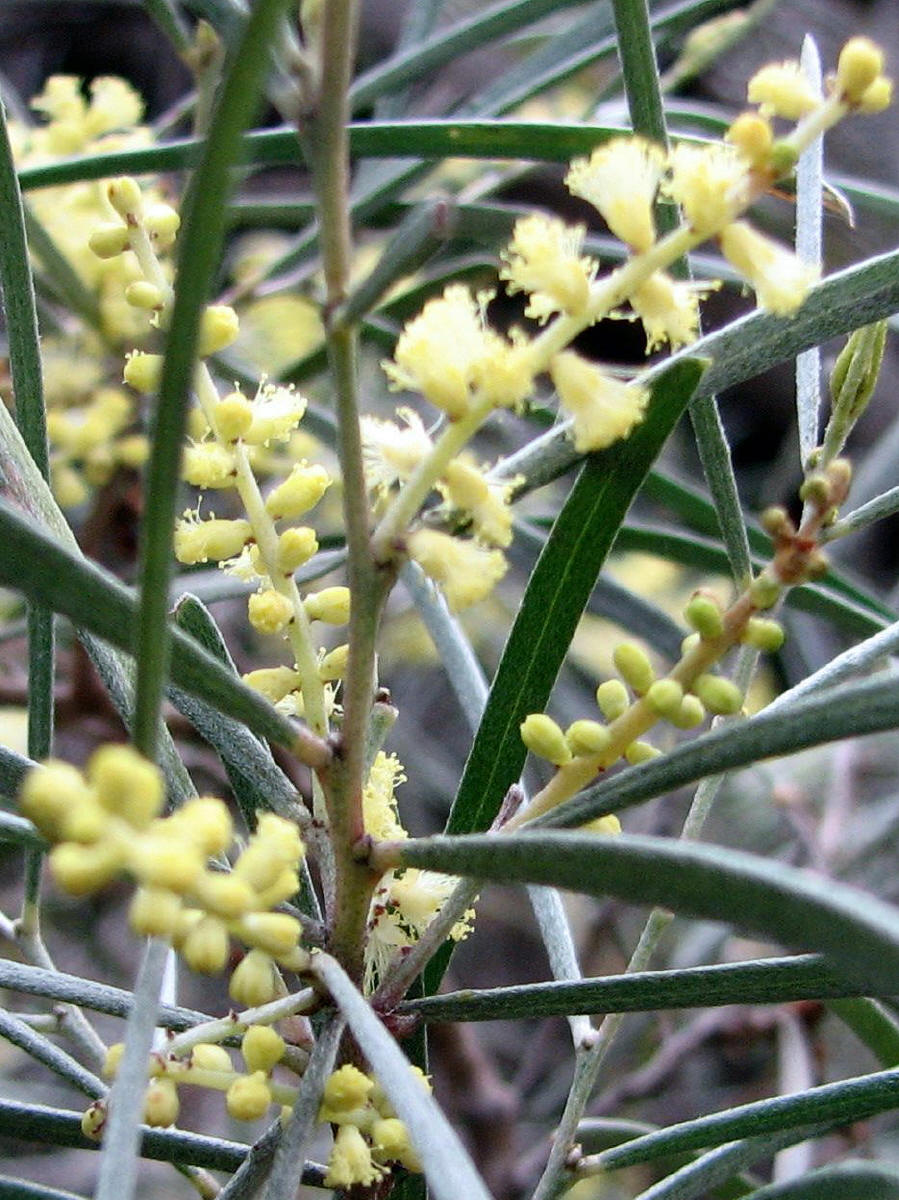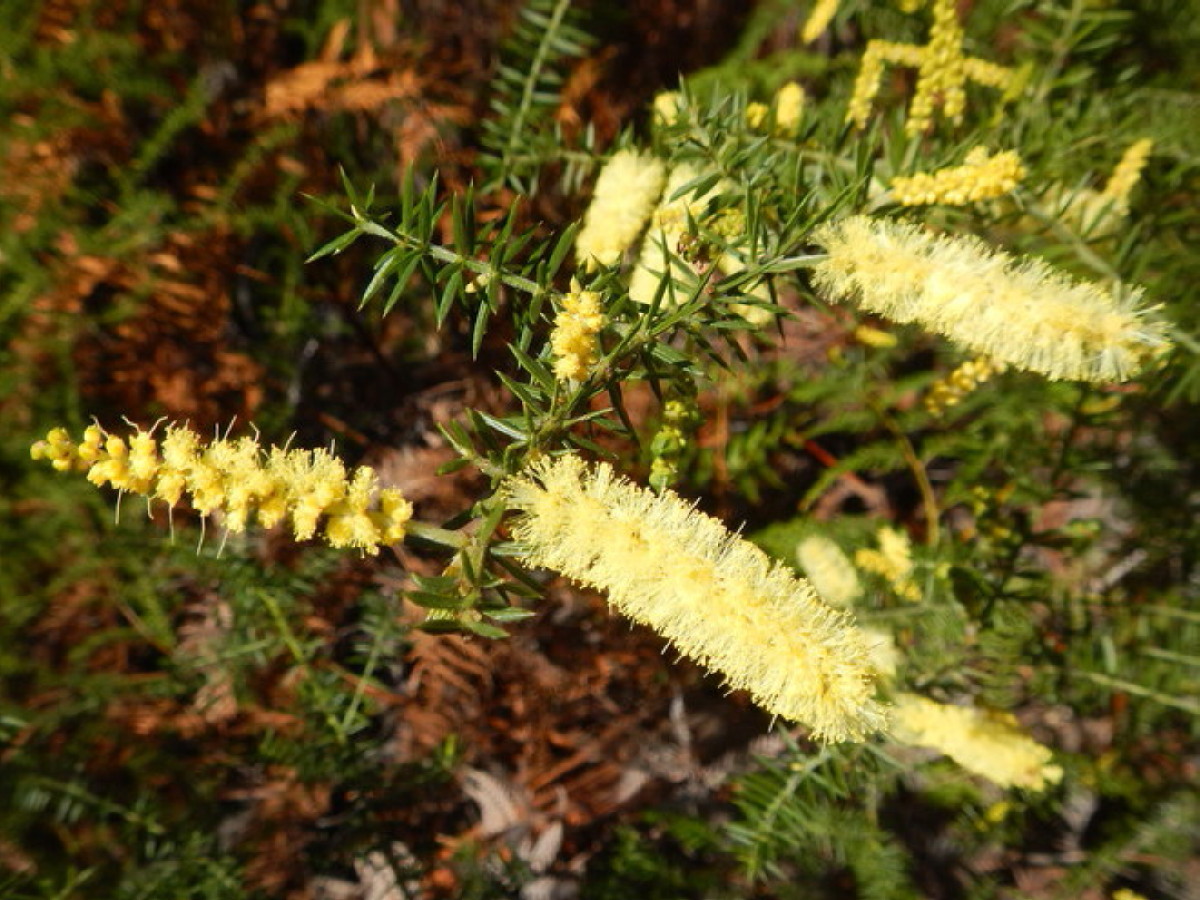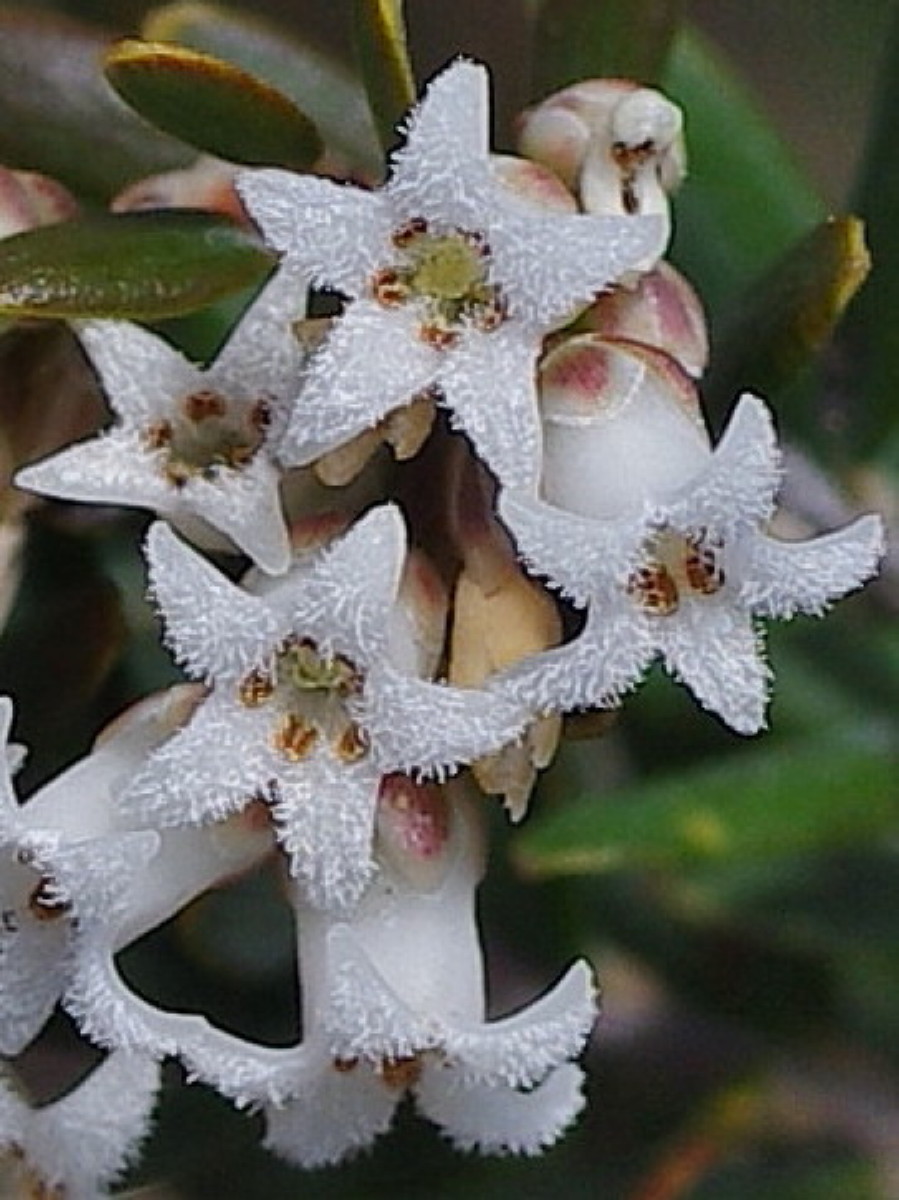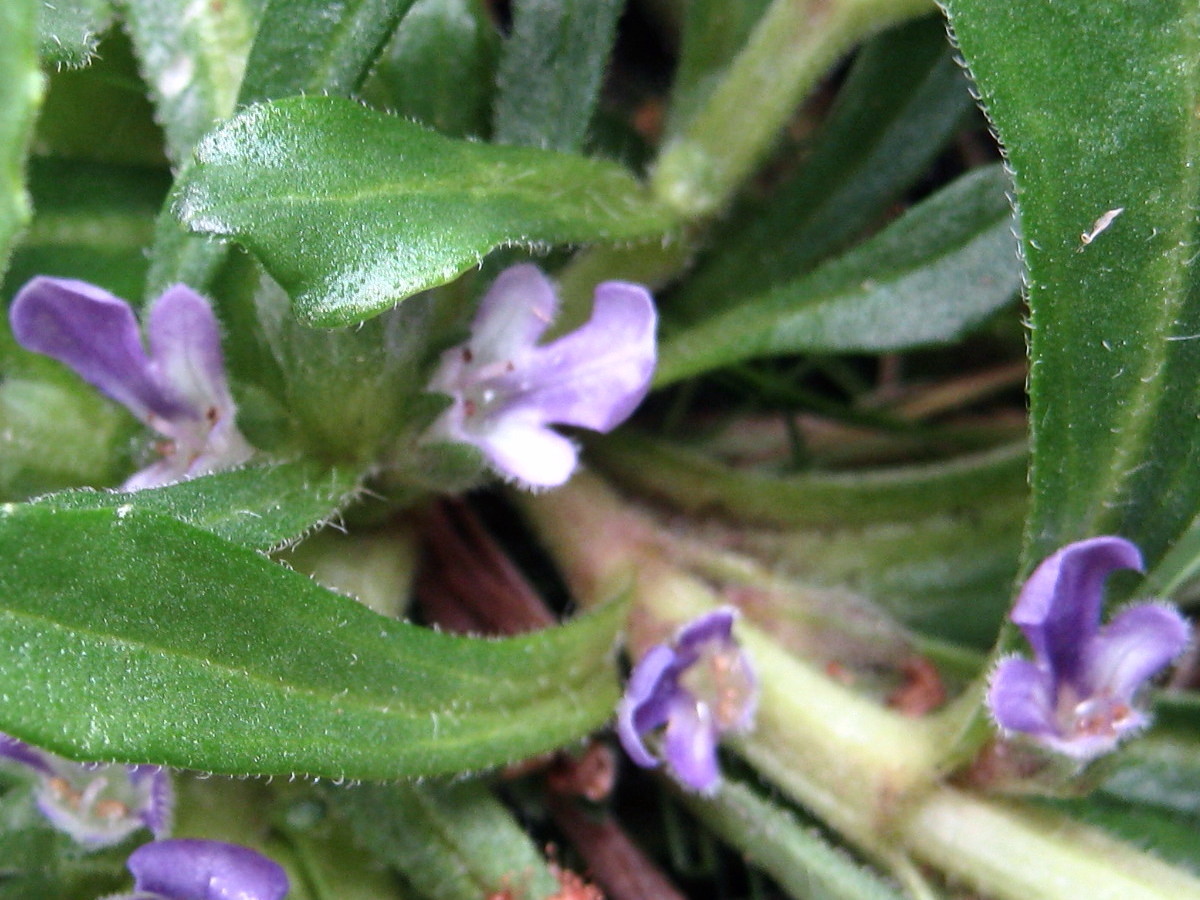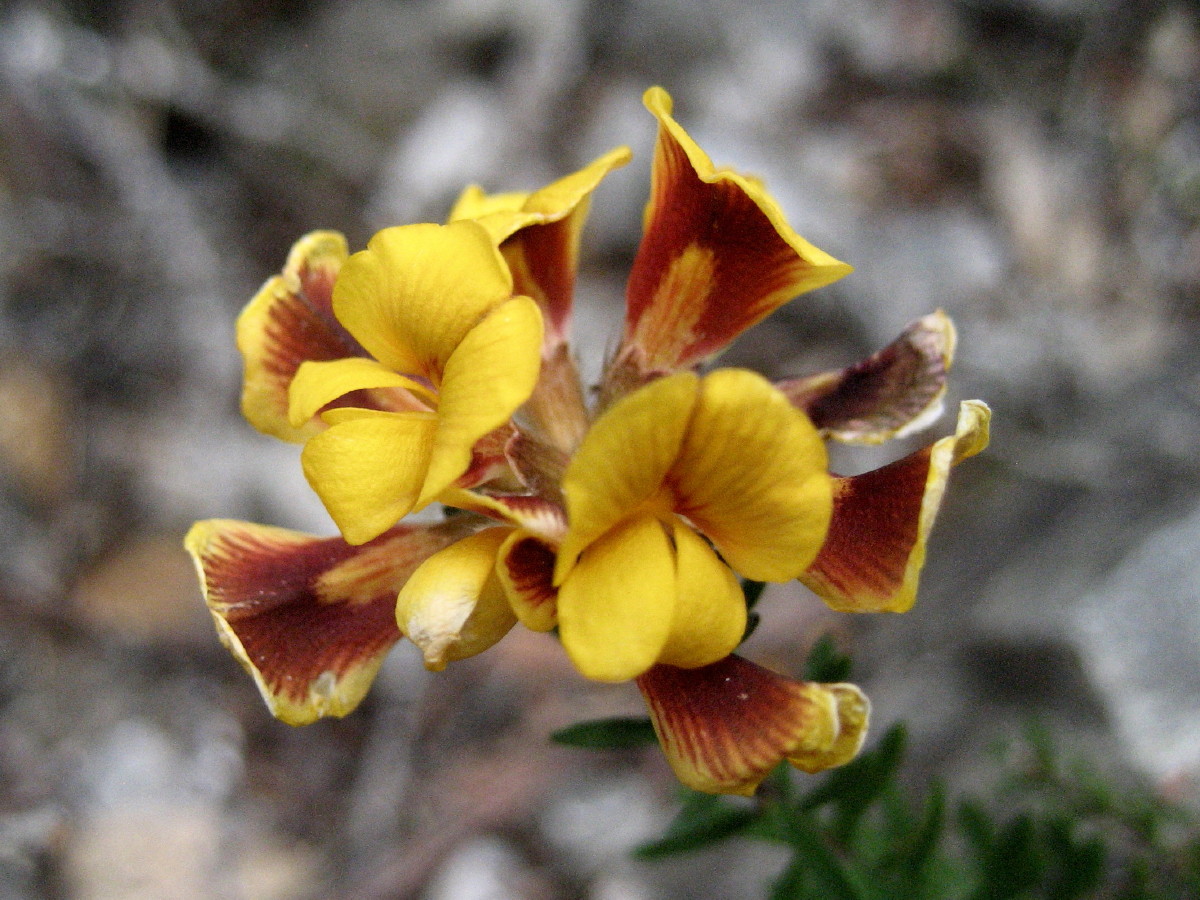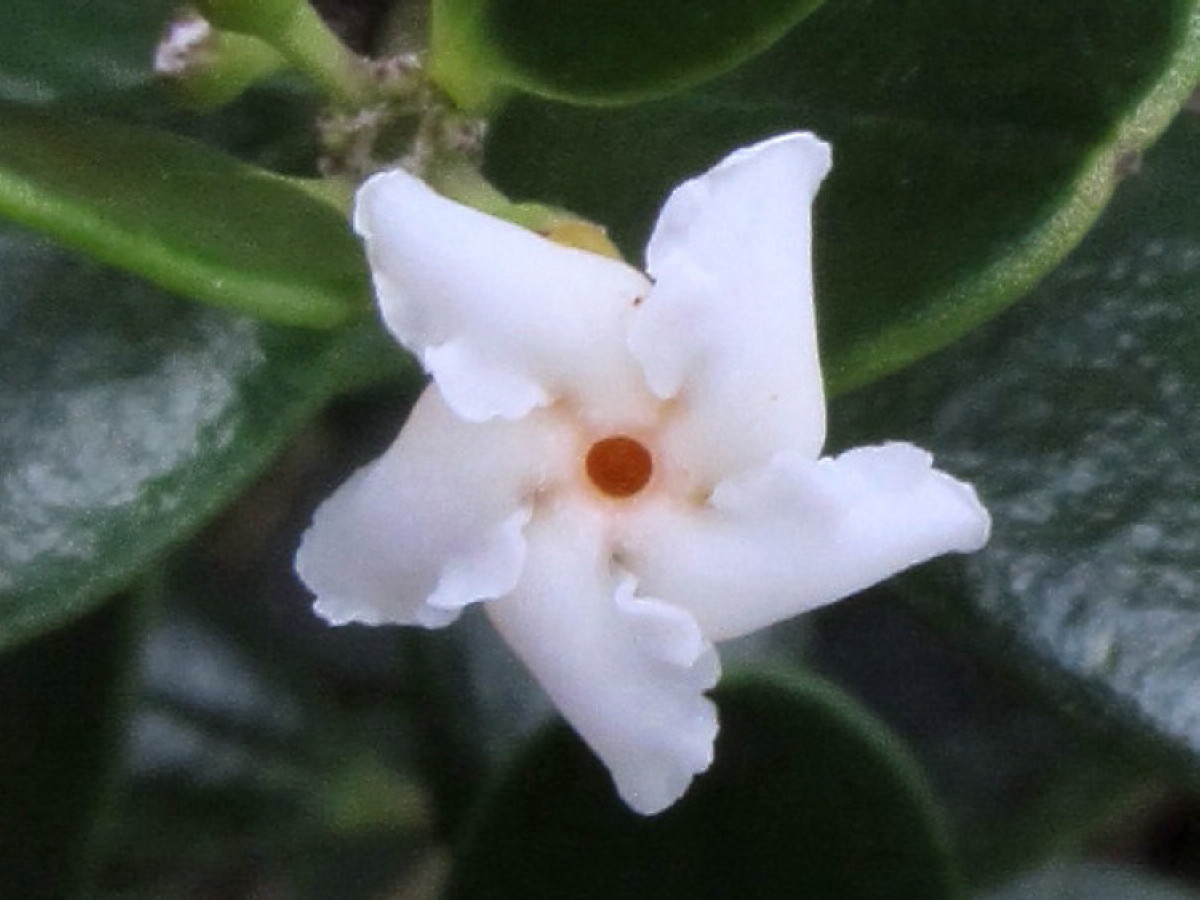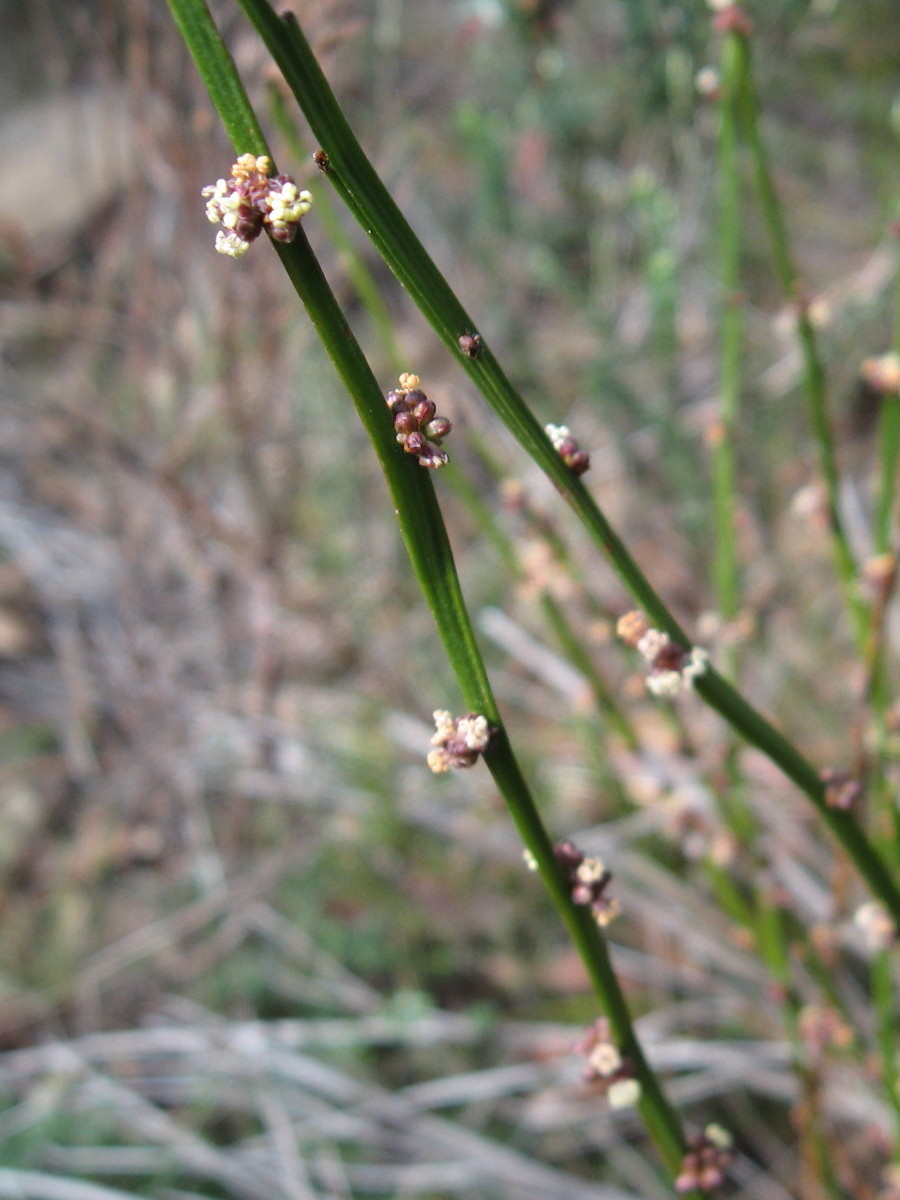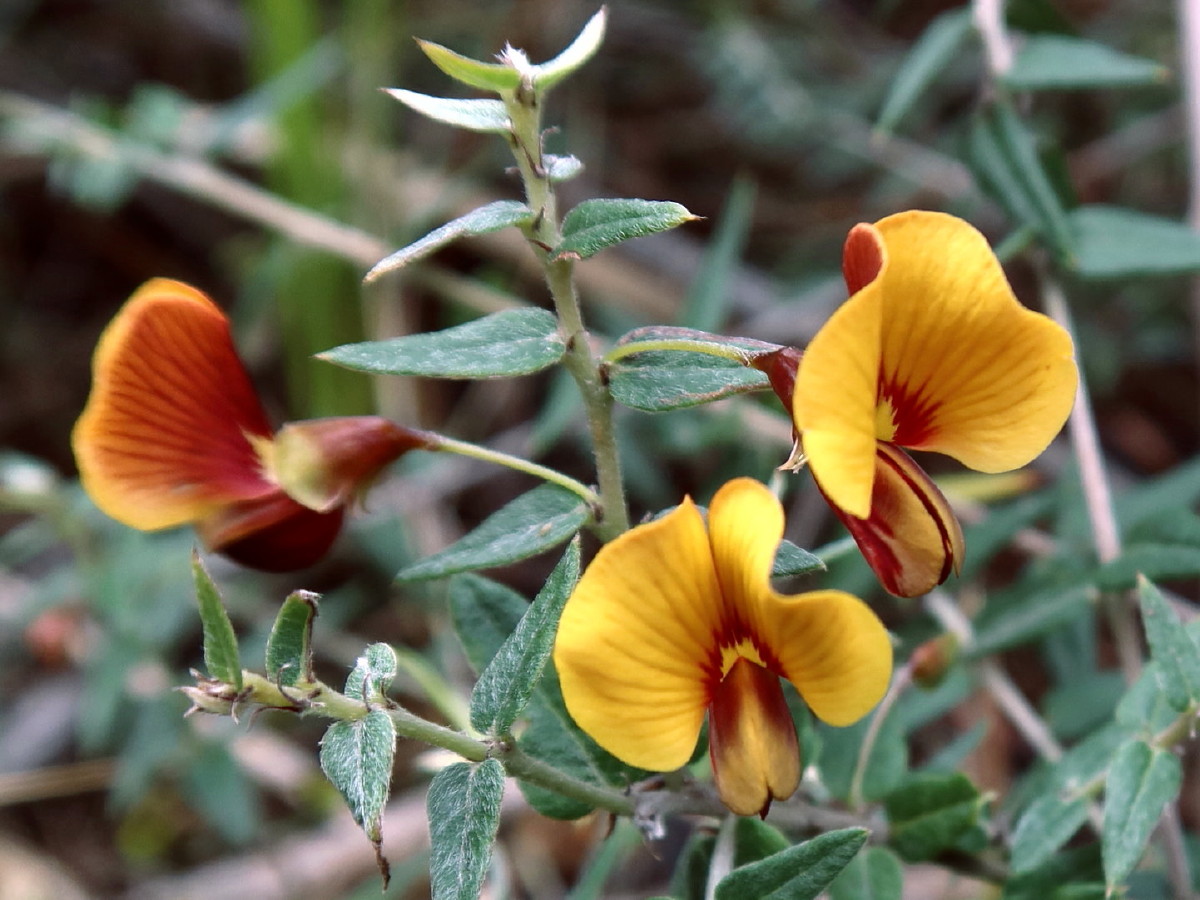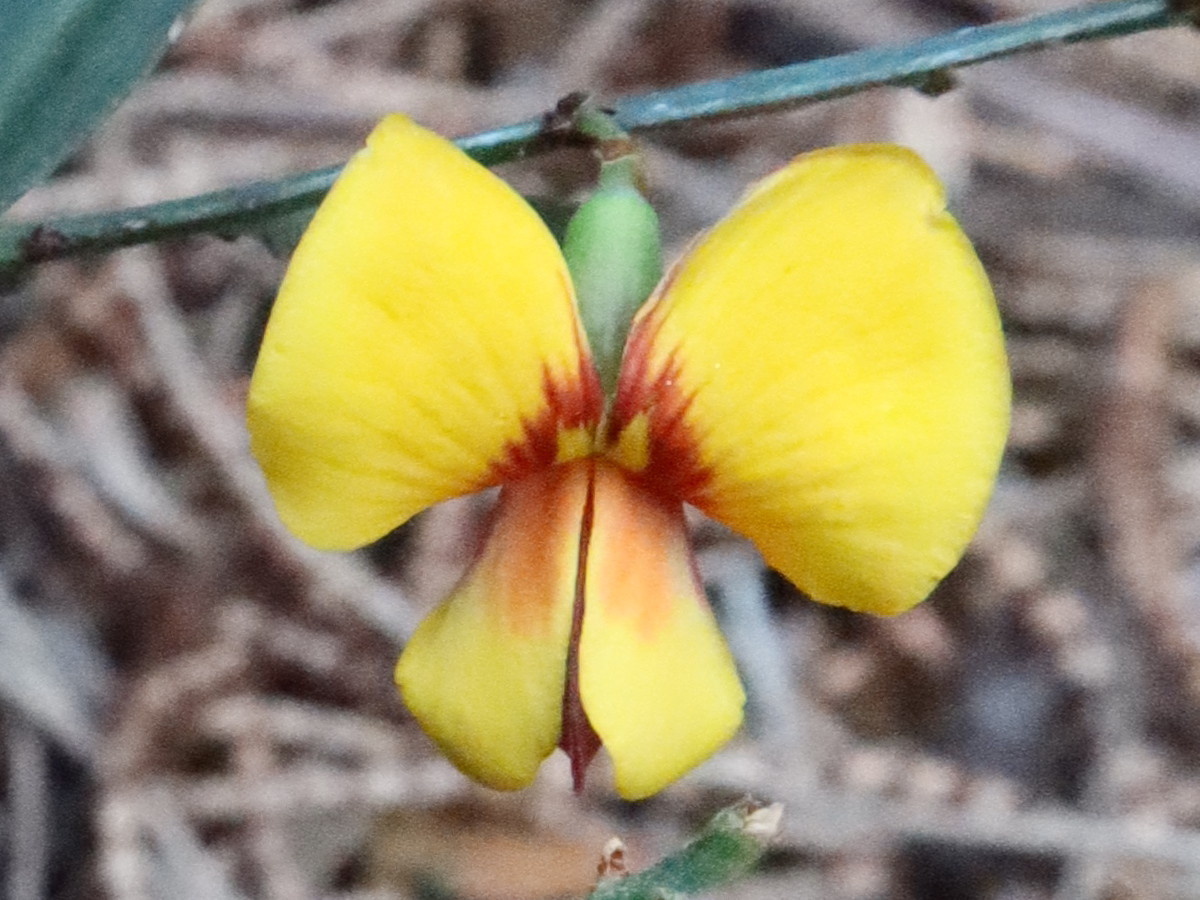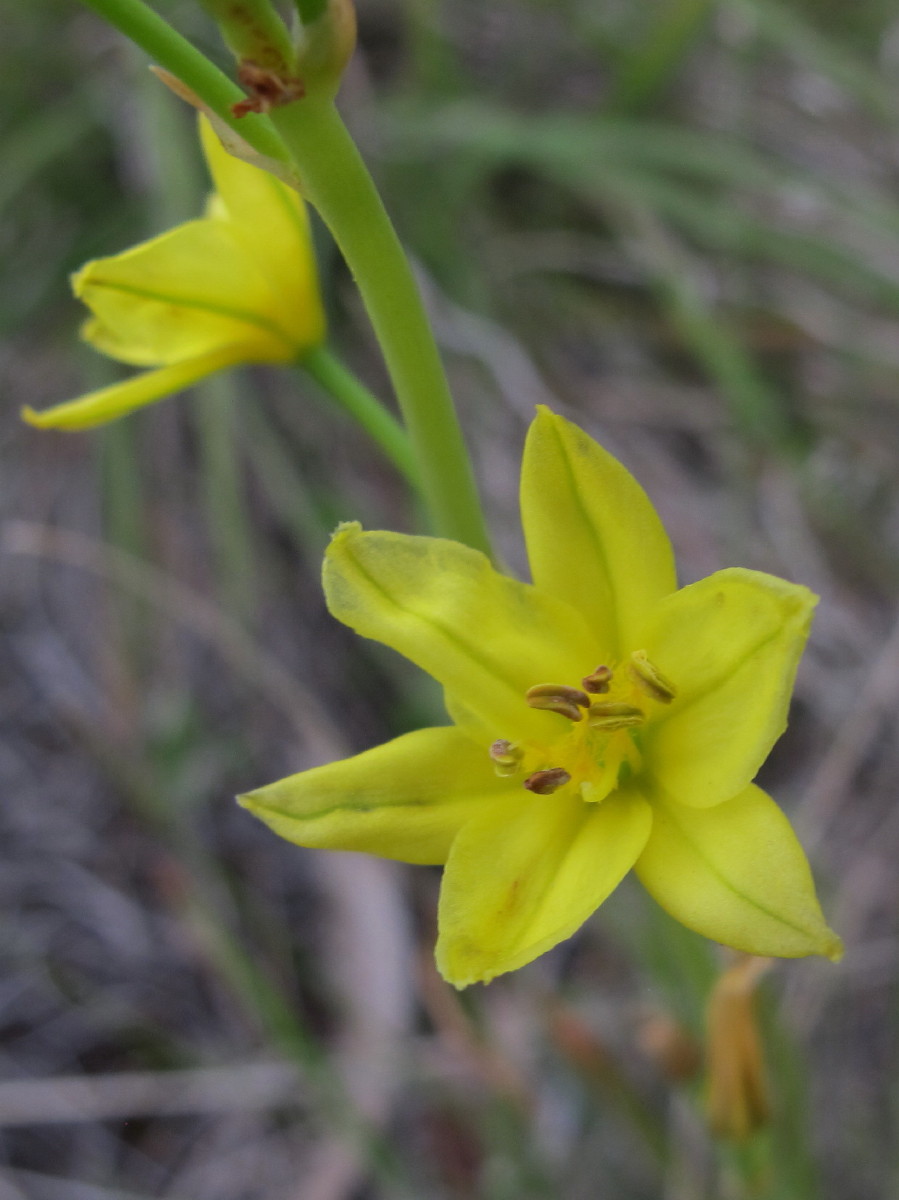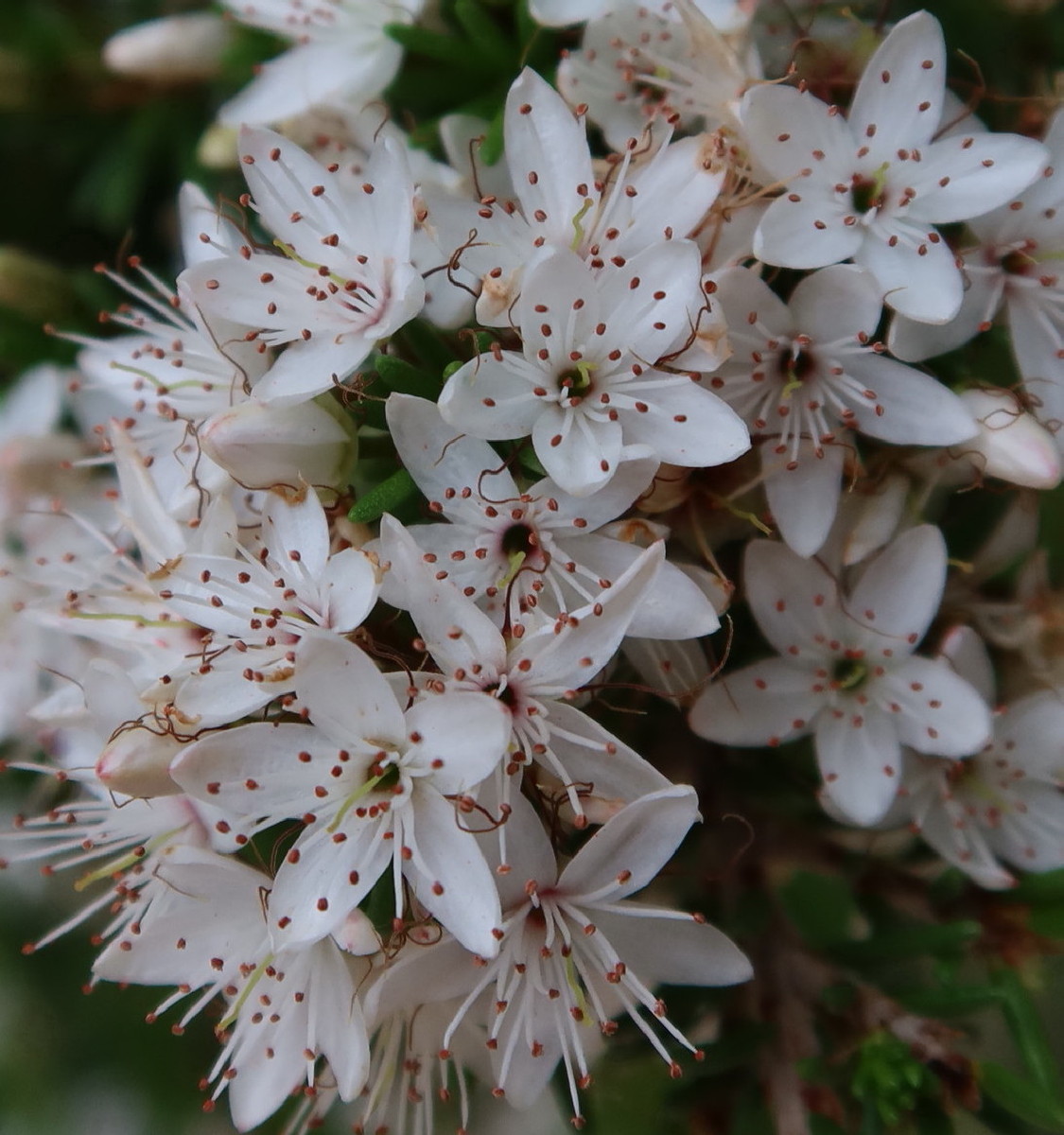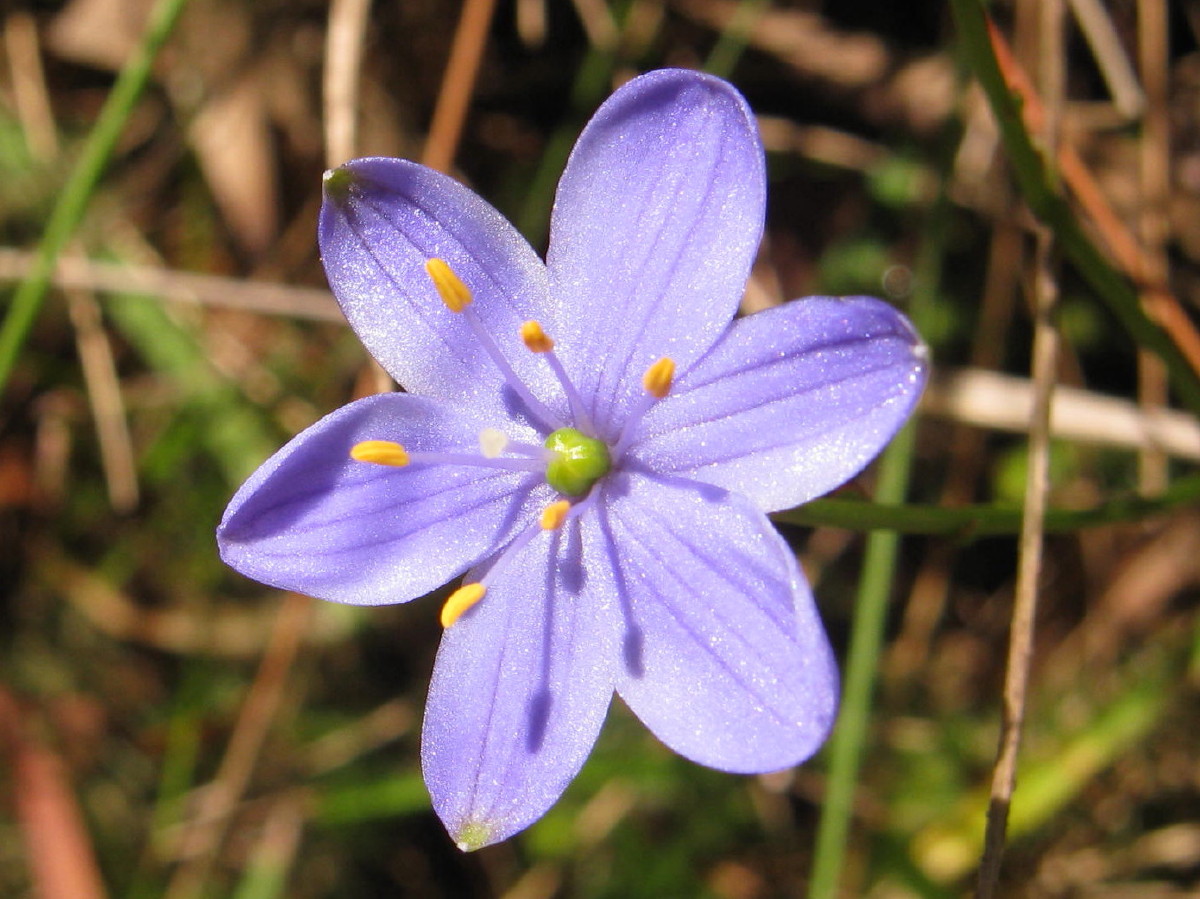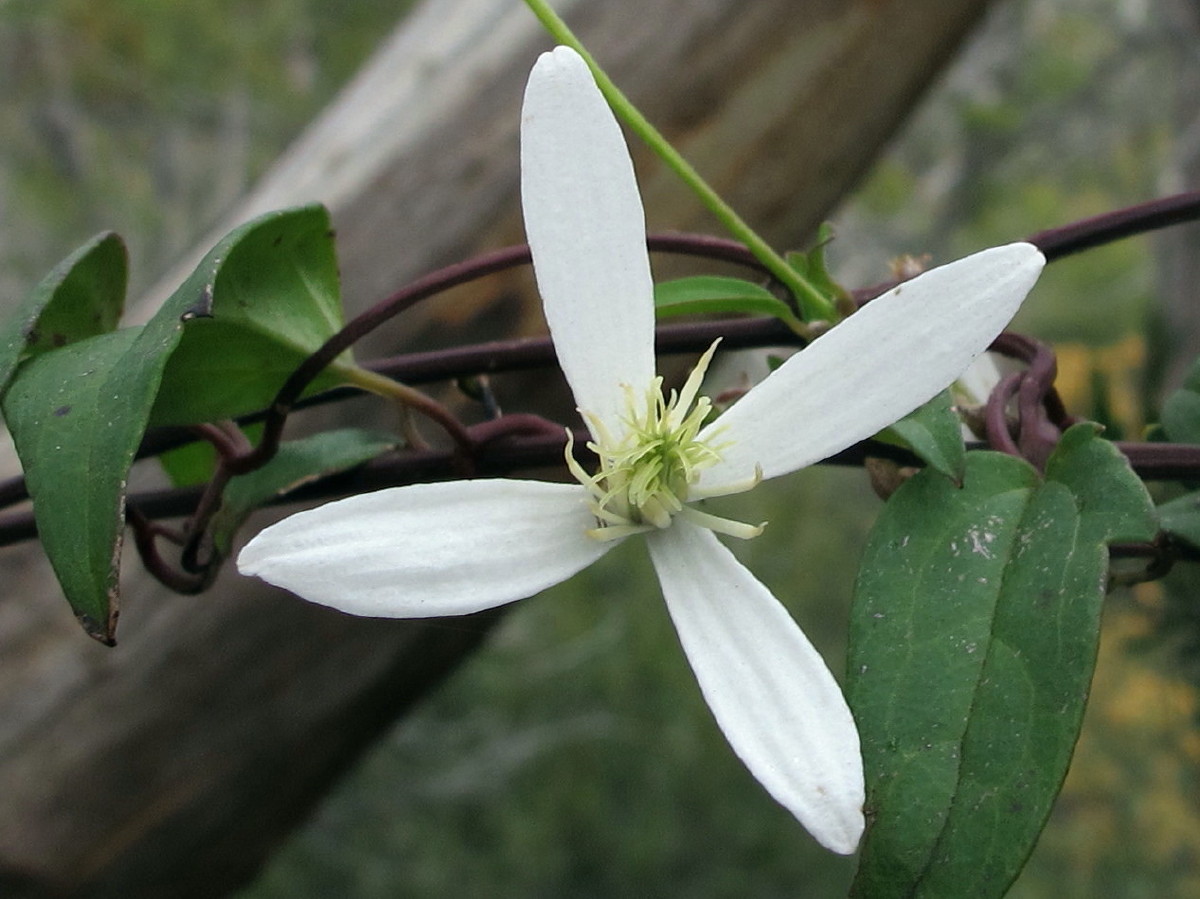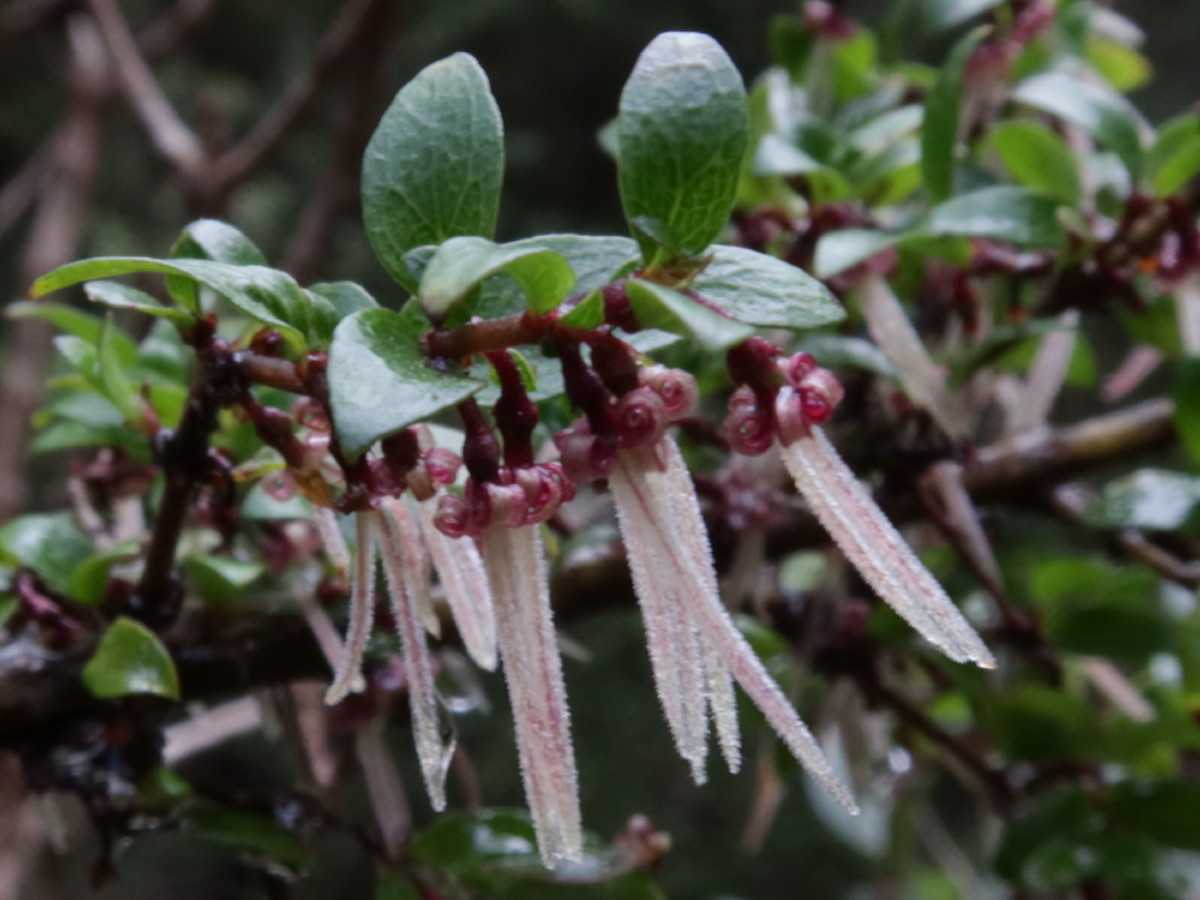Spring A-C
Looking at the photographs To view the photographs, click on the species image to enlarge it,
then use the side arrows to page through images of the flowers, buds, fruit, leaves, foliage and plant(s) in the wild etc.
Viewing the meaning of botanical words To view the meaning of botanical words, hold the cursor on the blue word and the meaning will appear in a text box. On phones, turn to landscape to view all.
Based on Debenham C’s, The Language of Botany, A Publication of The Society for Growing Australian Plants, Chipping Norton NSW, c.1962.
Acacia dealbata
Botanical Name: Acacia dealbata
Commonly Called: Silver wattle
Botanical Family: FABACEAE subfamily MIMOSIODEAE
Grows: This wide-spread tree grows typically 10 to 30m high by 5 to 10m wide. Low growing and even prostrate forms are found and cultivated. It can live for 30 to 40 years.
Foliage: The feathery, hairy leaves are silver-blue/grey and 1 to 12 and may be up to 17cm long. They are bipinnate with 6 to 30 pairs of pinnae. Each pinna has 10 to 68 pairs of leaflets. These leaflets are 0.7 to 6mm long by 0.4 to 1mm wide. A prominent gland occurs on the upper side of the rachis at the base of each pinnae pair.
Flowers: The inflorescences are large, fragrant, dense, terminal racemes of pale to bright yellow, globular, stalked flowerheads of 25 to 30 flowers.
Flowering Season: Flowers appear in late winter but mainly bloom in spring.
Fruit: The fruit are flattened pods, 2 to 11.5cm long by 6 to 14mm wide, blue/green when forming, then maturing to light brown. They contain several seeds and are often seen hanging on the trees in great profusion.
Habitat/distribution: This species tolerates a wide range of soil types but prefers moist soil in dappled shade, partial or full sun. It often grows in high rainfall areas where the trunks are sometimes densely covered with white lichen. It is common throughout Tasmania except for a wide band down the west coast. It also grows in many places in Vic. and NSW.
Where found: It is found in Cradle Mountain – Lake St Clair, Freycinet, Hartz Mountains, Mount Field, Narawntapu, Rocky Cape and Tasman National Parks; Bluff River Gorge area and Tasmanian Bushland Gardens; Conningham, Diprose Lagoon, Geilston Bay and Government Hills, Meehan Range Conservation, Peter Murrell, Knocklofty, Ridgeway, Township Lagoon and Waterworks and Woodvine Reserves; the Tarkine; Old Convict Road, Luther Point to Stapleton Point and Thumbs and Flash Tiers in Orford area; and below 700m in kunanyi/Wellington Park; and many other bushland parks and gardens.
Other notes: This beautiful acacia, when mature, has close-grained timber and is used for furniture and other timber products. It is a good species for erosion control and shelter belts. It is easily propagated from hot water treated seed, but special forms, such as prostrate or low bushes must be propagated from cuttings. It is a post bush fire coloniser. When an area which has had this species growing is cleared and ploughed, it may be densely recolonised by seedlings if follow up clearing is not done. The prominent glands and the silver-blue/grey leaves distinguish this species from Acacia mearnsii and Acacia terminalis.
Acacia genistifolia
Botanical Name: Acacia genistifolia
Commonly Called: Spreading wattle
Botanical Family: FABACEAE subfamily MIMOSOIDEAE
Grows: This prickly shrub may be very prostrate to 0.1m or upright to 3m high. Some plants are straggly and sparse while others are very bushy. They spread from 1 to 3m wide.
Foliage: The spreading branches are rigid, angular and the smaller ones are coloured green. The phyllodes are scythe shaped or straight with a prominent central vein, 1 to 5cm long by 2 to 3mm wide.
These linear phyllodes are angled off the stem, sharply pointed and narrow at the base.
Flowers: The axillary inflorescences are 1 to 3 yellow spherical ball flowerheads on slender stalks 0.5 to 2cm long with about 20 flowers.
Flowering Season: The flowers appear in spring.
Fruit: The fruit is a flat, linear, thickened pod which grows 4 to 9cm long by 4 to 5mm wide. It matures to dark-brown with pale edges.
Habitat/distribution: This species is widespread and abundant in dry places, dry sclerophyll areas, and along roadsides as a prostrate or upright straggly, prickly shrub. It is also found in Vic and NSW.
Where found: Narawntapu National Park (NP) and around the Tamar Valley; a few places across the NE; many places down the east coast; and especially the SE area including Freycinet and Tasman NPs; Bluff River Gorge; Old Convict Road, Luther Point to Stapleton Point, Thumbs and Flash Tiers around Orford; lower areas in Wellington Park and many bushland parks and gardens. The prostrate form is widespread on North Bruny Island and occassionally in Knocklofty Reserve, West Hobart.
Other notes: Prostrate form comes true both from cuttings and seed; leaves have sharp points, so beware when weeding or pruning. Pruning after flowers usually encourages bushier growth, however hard pruning may result in dead stems.
Acacia gunnii
Botanical Name: Acacia gunnii
Commonly Called: Ploughshare wattle
Botanical Family: FABACEAE subfamily MIMOSOIDEAE genus ACACIA
Grows: This unique, small, prickly shrub grows 20 to 90cm high by 100 to 200cm wide.
Foliage: The alternate, sharp pointed, leathery, green phyllodes are narrow to broadly triangular, shaped like a ploughshare, and have a prominent gland at the tip of the rounded or acutely angled upper edge. These phyllodes grow 4 to 10 (up to 13)mm long by 2 to 5mm wide and have a major nerve usually near the approximately straight lower edge and have persistent stipules at their base.
Flowers: The flower head clusters are on a fine, sometimes hairy, 4 to 10mm long, axillary stalk. They are small, cream to pale yellow balls having 20 to 30 florets per cluster. These flower heads are usually one per axil.
Flowering Season: Flowers are seen from late winter through spring depending on the location and local conditions.
Fruit: The fruit are dark brown to black, narrow, some times hairy, leathery pods with thickened margins. They grow 20 to 40mm long by 3 to 6mm wide and are much constricted between the round, mottled, longitudinal seeds.
Habitat/distribution: Small localised populations are found in coastal and dry heathlands, dry woodlands and open forests in the north, east, northern midlands and south of Tasmania. It is also found in SA, Vic, NSW and Q.
Where found: It may be seen with permission, in private property on Richardsons Hill, Lauderdale; Hawthorn Drive Reserve, Maranoa Kingborough; Knocklofty Reserve, West Hobart; and Peter Murrell Reserve, Blackmans Bay; along the Cascade Walking Track, South Hobart; and Dirty Bridges Creek Track (Tangara Trail), Sandford; Narawantapu National Park, Bakers Beach; and other similar places.
Other notes: This species is a useful small plant for well drained light to heavy soils in sunny or part shade locations. It should be pruned after flowering, and may be propagated from hot water treated, 3 or more months old seeds or semi-hardwood cuttings. The shape of the phyllodes and their prominent glands are the distinguishing features compared to Acacia genistifolia and A. ulicifolia.
Acacia leprosa
Botanical Name: Acacia leprosa var. graveolens syn. A. verniciflua
Commonly Called: , Varnish wattle
Botanical Family: FABACEAE subfamily MIMOSOIDEAE genus ACACIA
Grows: This open small tree grows 2 to 5 (8) m high by 3 to 5m wide.
Foliage: The smooth grey bark is often mottled with white lichens. The angular branchlets have yellowish, resinous ribs which are hirsute or glabrous. The bright, shiny green, narrow elliptical to lanceolate phyllodes are (30) 50 to 110mm long by (3) 7 to 20 (30) mm. They have two prominent longitudinal veins and faint netlike laterals occur between tapering to the small, blunt, straight or curved point and, at the base into the small stalk. The phyllodes have a gland at or near the base.
Flowers: The large, dense flower clusters of pale bright yellow ovals or balls, 30 to 60 per head, grow on occasionally lanuginous pedicels, 3 to 10mm long, mostly as opposite pairs or 3 together in the leaf axils.
Flowering Season: Flowers appear in late winter and continue through spring.
Fruit: The fruit are leathery, mid brown pods, sticky when young, linear to narrow-oblong, 5 to 9cm long. They are rounded over and slightly constricted between the longitudinal seeds.
Habitat/distribution: Common and wide spread on damp, shady hillsides in wet sclerophyll forests from 500 to 600m and near sea level in some coastal areas. Also Vic, NSW, Q.
Where found: Throughout north and south east Tasmania especially in moister areas; Alum Cliffs Track, Bonnet Hill; Gravelly Ridge, Colebrook; upper Derwent Valley; lower slopes of kunanyi/Mt Wellington; Snug Tiers; and many other places.
Other notes: This hardy and adaptable small tree grows well in part shade and tolerates wet and dry periods. It may be pruned for shape. Propagation is best by hot water treated seed. The distinct veins along the phyllode are distinctive features.
Acacia melanoxylon
Botanical Name: Acacia melanoxylon
Commonly Called: Blackwood
Botanical Family: FABACEAE subfamily MIMOSOIDEAE genus ACACIA
Grows: This magnificent, usually densely foliaged, tree can grow 1.5 to 5m high by 5 wide in dry location and 10 to 30 (up to 50)m high with a 10 to 15m wide spreading crown in wet sclerophyll and rain forest locations.
Foliage: The juvenile bipinnate leaves sometimes persist until the plant is about 1m tall and sometimes recur if the plant is damaged. The adult foliage of grey/green phyllodes are 40 to 100m long by 7 to 20 (up to 25)mm wide are narrow elliptical to lanceolate, with 3 to 5 prominent veins and a network of minor nerves between them. The tips are blunt or pointed and the bases taper to 3 to 5mm stalks. A gland is present on each phyllode 0 to 10mm from the base.
Flowers: The aromatic flower clusters are pale yellow balls of 30 to 50 florets on thick 5 to 13mm long stalks, solitary or in short racemes.
Flowering Season: The flowers appear in late winter and can continue through to late spring.
Fruit: The pale to reddish brown, curved and twisted pods 50 to 100mm long by 3.5 to 8 (up to 10)mm wide have thickened edges and slight constrictions between the longitudinal shiny black seeds which are encircled almost or twice by a distinctive pink to bright red aril (seed-stalk).
Habitat/distribution: This species is widespread in wet sclerophyll forests, on rich loamy soils in wet gullies and forests as a tall tree with dense foliage. Sparse in dry sclerophyll as an open, tall shrub or small tree. It is also found in SA, Vic, NSW and Q.
Where found: Throughout Tasmania, especially wetter areas, all National Parks and many city parks and gardens. Places where it may easily be seen are Big Punch Bowl and Long Point TLC Reserve; Bluff River Gorge, Bridport Wildflower, Knocklofty – West Hobart, Old Convict Road to Probation Station and Thumbs – Orford and Peter Murrell Reserves; up to 1000m in kunanyi/Mount Wellington and Wellington Park; the Tarkine; Freycinet, Hartz Mountain, Mount Field, Narawntapu, Rocky Cape and Tasman National Parks.
Other notes: It is an excellent long-lived tree for parks and street trees, and on farms etc. for erosion control and shelter belts due to low growing branches. However, sheep and goats will eat off the lower branches as high as they can reach. Plants may sucker from damaged roots. The timber makes beautiful furniture, panelling and craftwork especially when sourced from wet sclerophyll areas when dark colouring can appear in the heart wood. Trees may be pruned for shape and size in home gardens. Propagation is easy from hot water soaked seed which is viable for many, many years if kept in a dry cool place.
Acacia mucronata subsp. longifolia
Botanical Name: Acacia mucronata subsp. longifolia
Commonly Called: Longleaf caterpillar wattle
Botanical Family: FABACEAE subfamily MIMOSOIDEAE genus ACACIA
Grows: This subspecies grows to become a tall shrub or slender tree up to 10m high.
Foliage: The oblanceolate phyllodes with 5 to 7 longitudinal veins are 4 to 5cm long by 3 to 5mm wide and have very blunt apex with an obvious mucro.
Flowers: The loose axillary cream/yellow flower spikes are shorter than the phyllodes.
Flowering Season: The flowers appear in late winter and can continue through to late spring.
Fruit: The straight, narrow-linear pods with slightly convex valves are 6 to 14cm long, have slightly thickened wavy edges and are scarcely constricted between the seeds.
Habitat/distribution: This species is widespread in wet sclerophyll forests, on rich loamy soils in wet gullies and forests as a tall tree with dense foliage. Sparse in dry sclerophyll as an open, tall shrub or small tree. It is also found in Vic.
Where found: It may be seen in many locations around Devonport; along the Huon and Picton Rivers also the Prosser River and its tributaries around Buckland; Badger, Big Dog, Cape Barren, Deal, Flinders and Passage Islands in the Furneaux Island Group and Three Hummock Island; Wineglass Bay, Freycinet Peninsula, and other places in Tasmania.
Other notes: This quick growing, hardy, tall shrub or small tree is suitable for screening, in a shelter belt or for a hedge. Propagation is by hot water treated seed. This species is the only non-endemic one of the three subspecies of Acacia mucronata in Tasmania. Acacia mucronata subsp. dependens and subsp. mucronata are described in the endemics “A-C” page of this website.
Acacia verticillata
Botanical Name: Acacia verticillata var. verticillata
Commonly Called: Prickly moses
Botanical Family: FABACEAE subfamily MIMOSOIDEAE genus ACACIA
Grows: This common and very wide spread prickly bush grows from 1 to 6m high by 3 to 5m wide, especially in damp areas or near creeks, sometimes forming dense thickets.
Foliage: The sharply pointed, elliptical, narrow phyllodes are 5 to 25mm long by 1 to 7mm wide with a gland at their base. They usually grow alternate or in whorls. The angular branchlets are often pubescent.
Flowers: The flower clusters are dense cylindrical or ovoid, mid to bright yellow spikes, 30 to 40mm long. They grow on glabrous or pubescent (5) 10 to 20mm long stalks, singly or up to three in the leaf axils.
Flowering Season: The flower spikes appear from mid winter to the end of spring.
Fruit: The fruit are linear pods, 30 to 80mm long by 3 to 5mm wide, maturing to dark brown. They are lightly constricted between the longitudinal seeds.
Habitat/distribution: This bright green prickly shrub is Widespread especially in damp places. It is also found in SA, Vic and NSW.
Where found: Throughout Tasmania, especially damp areas; Big Punch Bowl and Long Point Tasmanian Land Conservancy reserve; Bluff River Gorge, Knocklofty, Peter Murrell and Wingara Gully Reserves;
Mt Field, Narawntapu, Rocky Cape and Tasman National Parks; Kunanyi/Wellington Park lower areas; The Tarkine; Old Convict Road & Probation Station, Luther to Stapleton Points Track, Orford Thumbs and Flash Tiers Orford Reserves;
Flinders, King, Deal, Cape Barron and Clark Bass Straight Islands; Maria and Maatsuyker Islands; and many bushland parks and gardens.
Other notes: Useful as a coloniser of disturbed ground. Provides good habitat for small birds. May be easily propagated from hot water treated several months old seed or semi-hard wood cuttings.
Plants may be pruned after flowering for shape and to prevent them becoming too tall or leggy. Two other subspecies are found in Tasmania: A. verticillata subsp. ovoidea, Prostrate prickly moses, and A. verticillata subsp. ruscifolia, Broadleaf prickly moses from the west coast.
Acrothamnus hookeri
Botanical Name: Acrothamnus hookeri<br
Commonly Called: Mountain beardheath
Botanical Family: Epacridoideae Tribe 6 Stypheliae
Grows: This small, pretty, white flowering, woody, shrub grows 20 to 40cm high by 15 to 20cm wide, and has persistent fruit.
Foliage: This species has 4 to 10mm long, pointed, stem-clasping, alternate leaves. Their upper surface is green and their lower surface is grey with several parallel veins.
Flowers: The tubular, unisexual, white flowers, with bearded throat, grow in terminal spikes.
Flowering Season: The flowers appear in late spring.
Fruit: The fruit is a 2 to 3mm diameter red to brown fleshy drupe which appears in summer, then drops off, when ripe, prior to winter.
Habitat/distribution: This species is wide-spread in elevated areas of alpine grassy heathlands. It also grows in NSW and Vic.
Where found: It has been recorded and/or found in: Cradle Mountain-Lake St Claire National Park (NP); Urquhart Track and other locations in Mount Field NP; Liawenee and Lake Augusta areas; Great Lake area; Miena, Breona and The Steppes in the Central Plateau area; and generally in the Central and Central northwest of the state; possibly kunanyi/Mount Wellington; and possibly some high elevation home gardens.
Other notes: This attractive pretty white heath flowering shrub with decorative fruit, although not widely grown, is suitable for rockeries and plant pots. It requires moist soil with good drainage. Propagation is from seed or by tip cuttings. Its bearded, floral-tube throat distinguishes it from Acrothamnus montanus.
Ajuga australis
Botanical Name: Ajuga australis
Commonly Called: Australian bugle
Botanical Family: Lamiaceae
Grows: This variable, small, clumping herb grows 10 to 60cm high by 10 to 50cm wide with spreading roots from a short broad rootstock.
Foliage: The 4 to 30cm high flowering stems arise from a rosette of basal leaves. The rosette leaves and those up the lower part of the stem have petioles sometimes as long as the 2.5 to 8.0cm obovate or ovate oblong, bluntly and distantly toothed leaf blades. The often soft and greyish leaves with both surfaces pubescent or villous are sometimes green and almost glabrous.
Flowers: The usually about 10-flowered floral whores are sometimes crowded at the end of the stems in a terminal spike-like inflorescence but distant below and sometimes all whorls distant. The 5 to 7mm long , more or less pubescent calyx has 5 lanceolate teeth about as long as the tube. The blue, purple or deep pink corolla is 10 to 15mm long and the tube is scarcely longer than the calyx, while the lower lip is spreading and the middle lobe is emarginate.
Flowering Season: The flowers appear through spring and summer.
Fruit: The fruit are shiny round wrinkled nutlets as large as 3mm long.
Habitat/distribution: Widespread and common in damp, sandy, grassy areas. It is also indigenous in SA, Vic, NSW and Qld.
Where found: It has been seen and/or recorded in Bluff River Gorge, Bridport, Buckland; Cheltenham Reserve, Newham; Cradle Mountain Lake St Claire and Rocky Cape National Parks; Liawenee Lake Augusta and Lake Ada areas; north of Flagstaff Hill and the northern Skyline Trail Meehan Range, Cambridge; the Tarkine area; Badger, Bruny, Clarke, Flinders and King Islands; Pelverata Falls Track, Pelverata and many other places throughout the State.
Other notes: This hardy spreading herb will grow in many soil types and climates and in full to part shade. It is a matting plant suitable for coastal erosion control. The distinguishing features are the erect blue/pink flowers in false whorls arising from a rosette of hairy, soft leaves flat leaves.
Almaleea subumbellata
Botanical Name: Almaleea subumbellata
Commonly Called: Wiry bushpea
Botanical Family: Fabaceae
Grows: This woody, rigid, sprawling sub-alpine shrub grows 30 to 90cm high by 20 to 30cm wide in riparian areas, around tarns and in damp heaths.
Foliage: The branchlets often grow in 4 to 8 false whorls. The 5 to 12mm long by 1 to 2mm wide, glabrous narrowly ovate to oblong leaves are crowded with a rounded or acute apex. The lower surface usually has a broad central purple-brown band and villous, marginal hairs. The edges are slightly incurved and about 0.5mm long stipules are closely appressed to the stem.
Flowers: The 4 to 10-flowered floral whorls are crowded at the end of the stems. The yellow pea flowers have purple markings on their standard and wings. The broadly lanceolate 2 to 3mm long outer bracts are densely ciliate at their base but glabrous at their apex. The densely hairy, narrow lanceolate, inner bracts are the same length. The calyx is 3.5 to 5mm long and the base of the tube is glabrous while the lobes are hairy. Narrow lanceolate, 2 to 3mm long, densely hairy bracteoles are attached to the pedicel immediately below the base of the calyx tube. The ovary and base of the style are also densely hairy.
Flowering Season: The flowers appear through spring and early summer.
Fruit: The fruit is an inflated small pod.
Habitat/distribution: This pretty little yellow flowering shrub is widespread and common around tarns and along riparian strips and, also in damp heathlands. It is also indigenous in Vic and NSW.
Where found: It has been seen and/or recorded in Cradle Mountain-Lake St Claire, Mount Field and Rocky Cape National Parks (NPs); Bluff Hill, Marrawah; Eagle Hawk Neck, Tasman Peninsula; Henry Somerset Conservation (private) Area (HSCA), Latrobe; Highland Lakes Road, Miena area; Mt. Killiecrankie and several other locations on Flinders Island; River Derwent, above Hayes (Jail Farm); Snug Tiers, Pelverata; many other locations in the east and mid-north of the State.
Other notes: This hardy erect, woody shrub will grow best in well-drained moist soil with part shade. It is suitable for containers, rockeries or normal garden beds. The distinguishing features are the small floral bracts.
Alyxia buxifolia
Botanical Name: Alyxia buxifolia
Commonly Called: Seabox
Botanical Family: Apocynaceae
.
Grows: This woody, rigid, sprawling, coastal bush grows from almost prostrate i.e. 0.2 up to 2.5m high by 1 to 3m wide on rocky foreshores.
Foliage: The branchlets are ridged by the decurrent bases of the leaves and they bear the prominent raised scars of leaves and peduncles. The shortly stalked 1 to 3.5cm long leaves are usually opposite but occasionally grow in whorls of 3. The oval-oblong, obovate or almost orbicular leaf-blades are coriaceous, have narrowly recurved margins, obscure veins and are glabrous with shiny upper surface.
Flowers: The strongly scented flowers with 1 to 2mm long pedicels grow 2 to 7 together in terminal clusters. The pedicels often lengthen in the fruiting stage. The broadly triangular about 1.5mm long sepals are ciliolate. The upper part of the 8 to 9mm long corolla-tube is orange and the throat is partly closed by a thick rim. The white lobes, 1/2 as long as the tube, are contorted in the bud and later are spreading. They are broad and asymmetrical while the upper of the overlapping edges are irregular, twisted and curled. The stamens with short filaments are joined to the upper part of the corolla-tube and the triangular anthers have a shortly pointed apex. The two carpels are joined at the apex by a simple style and the ovaries are surrounded by a dense ring of long hairs.
Flowering Season: The flowers appear through spring.
Fruit: The one or two, 6 to 10mm long fruit are orange to red more or less translucent, ovoid-orbicular drupes often with one seed. Sometimes moniliform and consisting of 2 or more 1 seeded parts.
Habitat/distribution: This species is found locally in the north and north-west coasts. It is also indigenous in coastal areas of southern SA, VIC, TAS, NSW, and SW WA.
Where found: It has been seen and/or recorded in Bridport; Schouten Island in Freycinet National Park (NP), and Rocky Cape NP; the Tarkine area; Badger, Bruny, Clarke, Flinders, King and many other small Bass Strait Islands; and the Skeleton Bay Grants Point Track, Binalong Bay, also other places throughout the State.
Other notes: This coastal species may be propagated from seed, or from cuttings which may be slow to strike. When garden planted, it needs to grow in very well-drained soil in full sun to part shade. It should be pruned for shape or a bushy habit. It may be suitable for coastal erosion control. The distinguishing features are the overlapping, spiralling white flower petals which make the flowers appear to be rotating and, the large red/orange fruit.
Amperea xiphoclada
Botanical Name: Amperea xiphoclada
Commonly Called: Broom spurge
Botanical Family: Euphorbiaceae
Grows: This floriferous small clumping understorey shrub grows 30 to 60cm high by 20 to 30cm wide. The plants are erect and open with rigid stems.
Foliage: The glabrous, greyish-green, flattish stems arising from a woody base have a central ridge on both sides, flat topped on new stems and rounding with age. The young stems often have alternate small leaves well apart up the sides of the flat edges. These very short stemmed leaves are broadly elliptical to obovate or oblong cuneate, or the upper ones often oblanceolate to lanceolate, +/- toothed and usually 5 to 15mm long; the floral leaves, when present, are smaller and narrow linear.
Flowers: The sessile male flowers are in clusters in the leaf axils surrounded by small, wide, brown bracts. The perianth, with 4 to 5 lobes is about 2mm long, has 6 to 9 free stamens the 2 anther-lobes are divergent and the filament has a distinct gland on its tip. The female flowers are usually single, but may be 2 or 3, also growing alone in the leaf nodes. However, sometimes the female flower grows to one side of a cluster of male flowers surrounded by small bracts. The female flower’s perianth is similar to the male flower but usually is more deeply lobed. The ovary has 6 locules and their valves have an acute tooth below the 3 entire or forked, broad, spreading and recurved stigmas. The style is very short.
Flowering Season: The flowers appear in spring.
Fruit: The fruit is a small, ovoid capsule about 4mm long with 6 teeth on its top. The seeds are oblong and smooth with a caruncle .
Habitat/distribution: Widespread and common in sandy heaths and poor soils. It is also indigenous in SA, Vic, NSW and Qld.
Where found: It has been seen and/or recorded on Tangara Trails Acton Park, Bluff River Gorge Buckland, Bridport Wildflower, Hawthorn Drive Kingborough, Knocklofty West Hobart, Luther to Stapleton Point Track Orford and Peter Murrell Reserves, also The Big Punch Bowl & Long Point TLC Reserves; kunanyi/Mount Wellington; the Tarkine; Freycinet, Narawntapu and Rocky Cape National Parks.
Other notes: This hardy small bush will grow in many soil types and climates and in full to part shade. Its natural shape and appearance lend to its use in landscaping. It may be propagated by cuttings or from seed. The distinguishing features are the tiny yellowish flowers and the erect, ridged, flat leaves.
Aotus ericoides
Botanical Name: Aotus ericoides
Commonly Called: Golden pea
Botanical Family: FABACEAE subfamily FABOIDEAE genus AOTUS
Grows: This floriferous small shrub grows 50 to 150cm high by 60 to 100mm wide. Some plants are open and have sparse foliage, others are compact with dense foliage.
Foliage: The many hairy branches have irregular whorls of three or more narrow leaves. These grow 5 to 12mm long and have edges rolled under almost to the centre. The upper surface of the leaves is usually glabrous and shiny but sometimes pubescent or scabrous. The underside is pubescent.
Flowers: The flowers are solitary or in clusters of 2 or 3 in the leaf axils, often forming dense leafy cylindrical or ovoid yellow spikes. They have 5 pubescent, joined sepals about 4mm long. The sepals’ lobes are as long as the slightly 2-lipped tube and the two upper lobes are broader. The yellow standard is crimson at its base, emarginate and twice as long as the sepals. The incurved keel is yellow or crimson.
Flowering Season: The flowers are best in mid spring.
Fruit: The fruit is a small, somewhat swollen, pilose, ovate pod.
Habitat/distribution: Widespread in the south east, up the east coast, along the northern coast, down the north west coast and coastal around the Macquarie Harbour. Also SA, Vic, NSW and Qld.
Where found: It has been seen and/or recorded in Bluff River Gorge; Bridport Wildflower, Diprose Lagoon Nature, Hawthorn (Maranoa Heights), Knocklofty and Peter Murrell Reserves; Freycinet including Schouten Island, Narawantapu, Rocky Cape and Tasman National Parks; Orford Luther Point to Stapleton Point Coastal Track; The Tarkine.
Other notes: This beautiful small bush requires part shade and well-drained soil. It may be propagated by cuttings or from seed. The distinguishing features are the pea flowers with erica-like leaves and the very hairy seed pods.
Arthropodium strictum
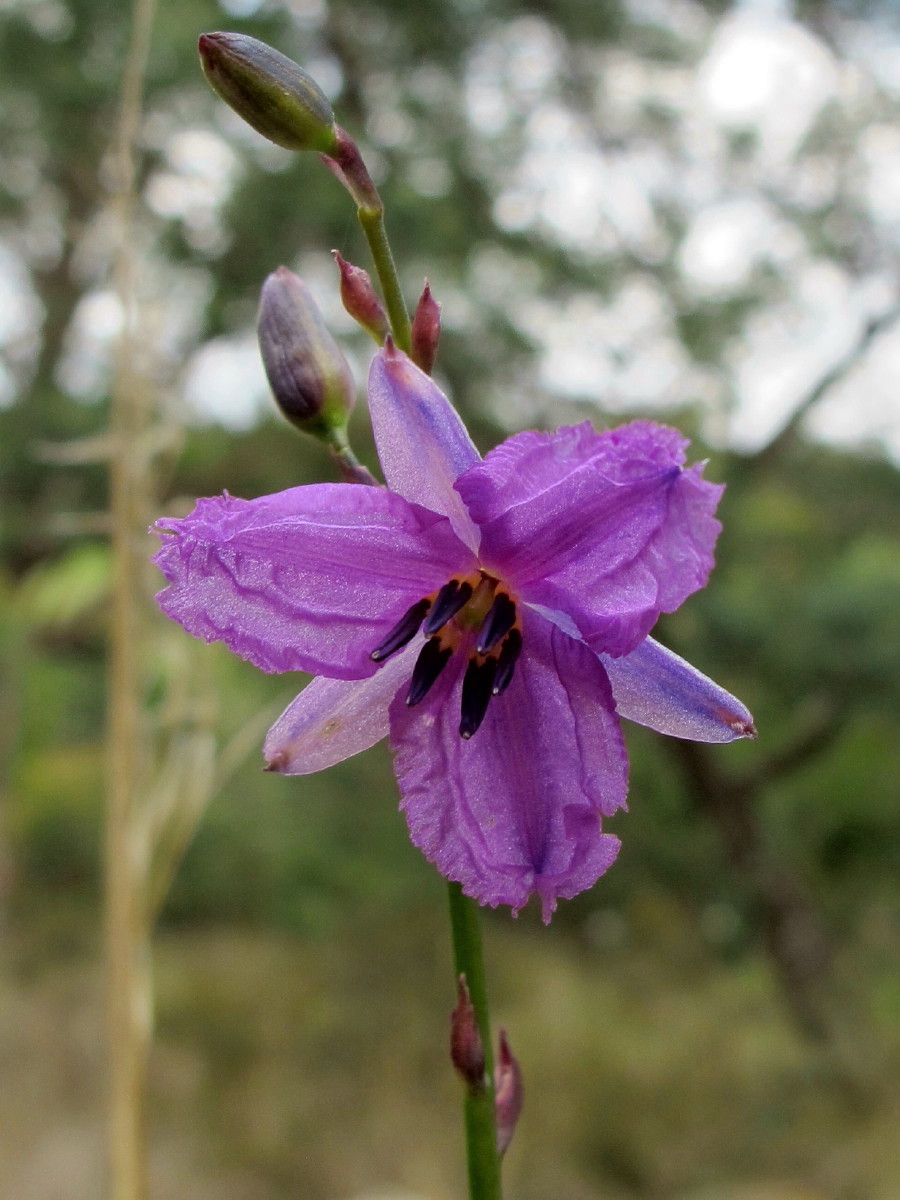
Botanical Name: Arthropodium strictum
Commonly Called: Chocolate lily
Botanical Family: Liliaceae
Grows: This pretty lily grows 50 to 90cm high from tuberous root stock which grows from a single tuber to a clump of many tubers. Each tuber produces one flower stem.
Foliage: The base of the plant is sheathed by persistent leaf fibres. The linear leaves are flat or slightly concave and grow 10 to 60cm long by 1 to 10mm wide.
Flowers: The flower stems are erect and usually branched. The deep pink, mauve or rarely blue flowers are solitary in the leaf axils and chocolate scented. The perianth segments are 6–14 mm long, spreading or slightly recurved and the petals are broader than the sepals with narrow, undulating margins. The stamens are shorter than the perianth segments and the anthers are purple, mostly with bright yellow appendages.
Flowering Season: The flowers are open from mid spring to early summer.
Fruit: The fruit is an ovoid capsule about 4 to 7mm long with seeds about 2 to 3mm long.
Habitat/distribution: This species is uncommon but widespread in the grasslands and dry forests of south east, east, north east and Midlands up to 300m. It is also indigenous to SA, Vic and NSW.
Where found: Bellerive; Breadalbane, Perth; Bridgenorth; Buckland area and Tasmanian Bushland Gardens, Buckland; Bonneys Plains and Boomers Bottom, Campbell Town; Conara; Distillery Creek Waverley, Launceston; Glebe Hill and Waverley Flora Park, Howrah; Knopwood Hill, Mornington; Pateena Rd – Mt Arnon; Powranna Road, Cressy; Sth Esk River, Perth; Brinktop Bushland Reserve, Richmond; Rokeby Hills and Oak Downs, Rokeby; Bridgenorth Road, Rosevale; Williamwood, Ross; Hillwood on Tamar River.
Other notes: This small lily requires sun and well-drained soil. It is an ideal container or rockery plant and may self seed once established. It may be propagated from seed or division. The distinguishing feature is the chocolate to vanilla aroma.
Bauera rubioides
Botanical Name: Bauera rubioides
Commonly Called: Wiry bauera, River or Dog rose
Botanical Family: Cunoniaceae
Grows: This pretty shrub scrambles up to 2m high with many branched stems. They can form almost impenetrable barriers due to the intermeshing stems. This feature makes them suitable for low hedges.
Foliage: The new stems are reddish pink and usually pubescent, while the older stems are reddish brown and sparsely pubescent. The shiny green leaves are in widely spaced horizontal whorls. The whorls consist of a pair of opposite leaves, each with three identical leaflets. The lanceolate-elliptical, acute, 4 to 14mm long leaflets are obscurely crenate with scattered hair or glabrous. These whorls are regularly spaced along nearly the full length of each stem and maintain their colour and shape for all the seasons.
Flowers: The delicate flowers are up to 2cm diameter and cup shaped. They are often pendulous and facing down on 25mm long stems exposing a ring of 6 to 8 toothed, 3 to 4mm long green sepals. The 4 to 10 petals, 6 to 8mm long, are usually white in Tasmania but may be pale to deep pink. They surround a large cluster of 30 to 90 but usually 50 to 60 yellow tipped stamens. The flowers of one species variation have multiple rings of petals. In NSW the flowers are usually pink, or sometimes white.
Flowering Season: The flowers are profuse from late spring and can continue sporadically into early winter.
Fruit: The fruit is a capsule.
Habitat/distribution: This species is common and widespread in shady moist areas and wet forests up to 1000m, especially along the west coast. It is also indigenous to SA, Vic and NSW.
Where found: Ben Lomond, Cradle Mountain Lake St. Clair, Freycinet, Hartz Mountain, Mt. Field, Narawntapu, Rocky Cape, South West and Wild Rivers, and Tasman National Parks; the Tarkine; Bluff River Gorge, kunanyi/Mt. Wellington, Mt. Read and Orford Thumbs Reserves.
Other notes: This scrambling spreading moist area bush is very useful for erosion control. It grows best in part sun; moist but well-drained soil. It may be propagated easily from cuttings which enables special forms to be cloned.
Boronia pilosa subsp. pilosa
Botanical Name: Boronia pilosa subsp. pilosa
Commonly Called: Hairy boronia
Botanical Family: Rutaceae
Grows: This small, slightly hairy, lightly scented shrub grows 0.3 to 3.0m high by 50 to 75cm wide.
Foliage: The stems and leaves are pilose. The compound pinnate leaves have 3 to 7 linear or oblanceolate, 5 to 15 mm long leaflets which are flat or slightly recurved with an acute tip and their rachis has a short petiole below the lower pair.
Flowers: The terminal and axillary flowers grow 3 to 6 together in small clusters on a short peduncle or sometimes solitary on pedicels equal or longer than the leaves. The lanceolate sepals are pubescent and the pink ovate petals are 5 to 7mm long. The pilose filaments are thickened and glandular behind the anthers.
Flowering Season: The flowers may be present through spring and summer.
Fruit: The fruit is a 4 celled capsule .
Habitat/distribution: This species is widespread from near sea level to 1000m. Around Hobart and down the coast to South Port, along the east, north east and north west coasts. It is also indigenous to SA and Vic.
Where found: This species may be found at Beaconsfield, Bicheno, Dazzler Range, Kellevie, Lake Pedder, Mt Eliza, Orford, Scamander, Sheffield, South Cape Bay, St Marys, Triabunna, Wedge River Wynyard and many other places; Bruny, Cape Baron, Clarke, Hunter, Maria and Robins Islands; Freycinet inc. Schouten Island, Rocky Cape, South West Wild Rivers and Tasman National Parks.
Other notes: This lightly aromatic small plant requires part sun and acidic, moist, well-drained soils. It should be pruned after flowering to maintain compact shape. It is best propagated from semi-hardwood cuttings. The slightly hairy all over leaves and stems, may be a distinguishing feature as may the slightly aromatic foliage.
The endemic subspecies occurring on the Tasman and Forestier Peninsulas, Boronia pilosa subsp. tasmanensis, Tasman hairy boronia, grows to 1.5m tall and has slightly longer and wider leaves and leaflets. Its flowers may be slightly more numerous, they may have white petals which may be longer.
Bossiaea cinerea
Botanical Name: Bossiaea cinerea
Commonly Called: Showy bossia
Botanical Family: Fabaceae
Grows: This erect, spreading, much branched shrub grows 30 to 120cm high by 1.5 to 2m wide.
Foliage: The branches are pubescent or villous. The alternate leaves, rigid and flat or edges recurved, are very, short stalked and grow 6 to 18mm long by 2 to 5mm wide. They are ovate-lanceolate to linear-lanceolate, the apex is acute, stiff and sharp, and the base is rounded and broad or cordate. The dark green upper surface of the adult leaves usually features a deep central vein and a shallow network of lateral veins. The lower surface is dull green and the light green juvenile leaves may be pubescent.
Flowers: The numerous and conspicuous flowers amid the branchlets are axillary on slender pedicels which are shorter than the leaves. The calyx of the bud is glabrous, flat and cuneate. In the flowering stage they are about 5mm long, the upper lobes are rounded and the lower lobes are very small. The yellow streaked with brownish-purple standard is more than twice as long as the calyx and broadly reniform. The lateral side petals and the keel are also purplish-brown. The ovary with 4 to 6 ovules is on a short gynophore.
Flowering Season: The flowers are present during spring.
Fruit: The fruit is a rounded pod 12 to 18mm long by 6 to 8mm wide on a stem about as long as the calyx.
Habitat/distribution: This species is widespread and abundant in heaths and dry sclerophyll forests up the Derwent River Valley, along the east and north east coasts and the South Esk and Tamar Valleys. It is also indigenous to SA, Vic and NSW.
Where found: This easily identified species is found in many Reserves including the following: Big Punch Bowl and Long Point Tasmanian Land Conservancy, Bridport Wildflower, Cape Deslacs Nature Reserve Clifton Beach, Cape Direction South Arm, Hawthorn Road Maranoa Kingston, Howden Coastal and Wingara Gully, Luther to Stapleton Points Coastal and Sandstone Quarry Orford, and Peter Murrell Blackmans Bay. It is also listed as present in the following National Parks: Freycinet inc. Schouten Island, Narawntapu, Rocky Cape and Tasman. It has been seen along Dawson Road Cluny, Old Monmouth and other Tangara Trails in Acton Park and Sandford.
Other notes: This attractive colourful plant tolerates part sun and moist, well-drained soils. With judicious pruning it is suitable for a low hedge or screening. It may be propagated from semi-hardwood cuttings or hot water treated seeds. The triangular leaves with a prominent central vein and the scrambling habit are distinguishing features.
Bossiaea riparia
Botanical Name: Bossiaea riparia
Commonly Called: Leafless bossia
Botanical Family: Fabaceae
Grows: This interesting, erect or prostrate, spreading, much branched, ‘leafless’ plant grows 0.5 to 1.5m high by 0.5 to 1.5m wide.
Foliage: The base of the stem is woody and stout and the green, very flattened, 1 to 4cm wide by 15 to 60cm long stems are many and spreading. On the older stems, minute brown scales arranged alternately at the angles of the stem represent leaves.
Flowers: The solitary flowers on short pedicels grow in the upper axils and develop from beautiful pink buds. The glabrous, about 4mm long calyx, has short lobes, the two upper ones are obliquely falcate and wider than the three lower ones. The petals are yellow with crimson throat and the standard is about as long as the calyx.
Flowering Season: The flowers are present during spring.
Fruit: The fruit is a glabrous pod about 18mm long by 5mm wide on a stem about as long as the calyx.
Habitat/distribution: This species is widespread and occasional in a wide range of habitats, from river banks at sea level to mountains at 1,300m. It is also indigenous to Vic and NSW.
Where found: This easily identified species is found in many locations including the following: Devils Gullet Walk – Upper Mersey and Forth and Township Lagoon Nature Reserves; Daniels Road near boom gate, Gravelly Ridge Conservation Area, Colebrook; Dawson Road Cluny at the Confluence of the Broad and Derwent Rivers, Ouse; Government Hills, Geilston Bay; Tasmanian Bushland Gardens and possibly other public gardens, also some private gardens.
Other notes: This flat stemmed plant prefers part sun and moist, well-drained soils. With judicious pruning it can be shaped into a neat clump. It may be propagated from cuttings or hot water treated seeds. The flat leafless stems are the distinguishing feature.
Brachyscome spathulata
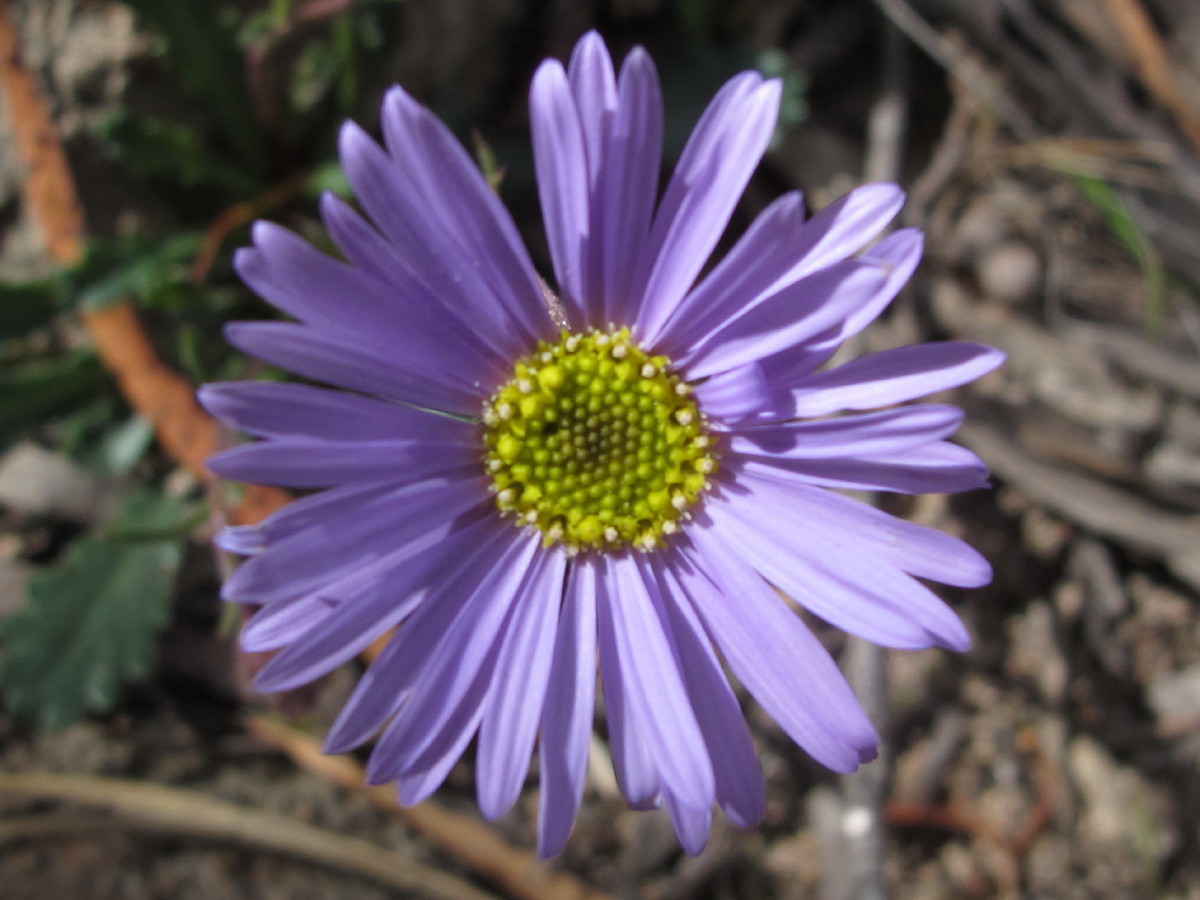
Botanical Name: Brachyscome spathulata
Commonly Called: Spoonleaf daisy
Botanical Family: Asteraceae
Grows: This typically mauve flowering herb grows 15 to 30cm high by 10 to 20cm wide
Foliage: The sessile rosette leaves from 30 to 60mm long by 8 to 34mm wide are spathulate and lobed. The oblong, upper leaves, also sessile, decrease in size up the hairy stem from 40 down to 5mm long by 11 down to 1mm wide.
Flora: The 30 to 40mm diameter daisy flowers have outer rings of about 22 to 52 or more, usually mauve to pale blue, and more rarely white, ray florets. These petal-like flower parts are 7 to 15mm long and enclose the upright yellow pollen bearing stamens. They surround many yellow tubular disc florets in the centre of the flower.
Flowering Season: The flowers appear in late spring and continue through to early autumn.
Fruit: The fruit are somewhat flattened, obovate achenes.
Habitat/distribution: Very widespread throughout Tasmania from sea level up to 1300m in sub-alpine woodlands, heathlands, grasslands and dry forests. It is also found in the ACT, NSW and Vic.
Where found: Bruny, Flinders, King and Maria Islands; Ben Lomond – sub alpine, Mount Barrow, Cradle Mountain /Lake St. Clair, Mount Field and Tasman National Parks ; Cheltenham, Knocklofty, Flash Tiers – Orford Thumbs, Orford Convict Road and Probation Station, and Peter Murrell Reserves; kunanyi/Wellington Park; many other parks, reserves and gardens.
Other notes: Best grown in a cluster as understory plants in semi-shaded moist soil with gastropod protection. May be propagated by cuttings, division and fresh seed. The mauve colour of the ray florets and the thick leaves are distinguishing features.
Brachyscome spathulata subsp. glauca, Blue daisy, was reclassified back into the main species in 2014.
Bulbine glauca
Botanical Name: Bulbine glauca
Commonly Called: Bluish bulbine-lily
Botanical Family: Liliaceae
Grows: A beautiful clumping plant growing 15 to 60cm high by 10 to 30cm wide.
Foliage: The tufted, bluish green, up to 30cm long leaves are succulent, linear, furrowed and taper to a pointed tip.
Flowers: The flowers grow on a spike up to 50cm tall with the multiple flowers opening one at a time for a day or two each. The flowers have six yellow broadly lanceolate petals and the stamens have a cluster of bearded filaments inserted 1 to 2mm below the anther. The anther turns sideways after pollen dispersal and arches over. The sigmoid style is 3 to 7mm long with a minute entire stigma.
Flowering Season: Spring/summer
Fruit: A globular capsule containing many seeds, 4 to 5mm diameter, on an erect pedicel elongating after flowering and up to 22mm long.
Habitat/distribution: Tolerates a wide range of conditions from coastal dunes and heaths to 250m altitude and rocky outcrops or damp sandy soils under light forest cover. Also Vic, NSW and possibly Qld.
Where found: Waverley Flora Park and Coastal track around Rosny Hill, Bellerive; Big Punch Bowl and Long Point TLC Reserve; Bluff River, Bridport Wildflower, Coningham, Diprose Lagoon Nature and Knocklofty Reserves; Maria Island National Park; St Marys, Scamander, along NE coast; Northern Flinders Island; Launceston and other places.
Other notes: The Golden bulbine-lily, Bulbine bulbosa, has a bulb like tuber, greener leaves and is rarer than the Bluish bulbine-lily. Its staminal filaments are directly under the anther. Mass planted Bulbine glauca provides an outstanding display when in full flower. Propagation by fresh seed is easy and reliable.
Calytrix tetragona
Botanical Name: Calytrix tetragona
Commonly Called: Common fringe-myrtle
Botanical Family: Myrtaceae
Grows: This dense foliaged floriferous species is much branched and grows 0.5 to 3m high. The branches are glabrous or slightly or densely covered with hairs.
Foliage: The bright green linear, round or triangular leaves are 3 to 6mm long with a very short stem and the tip is blunt or with a small mucro.
Flowers: The pale pink, sometimes white, flowers with tiny stems at the base of 8 to 12mm long hypanthiums (which resemble stems) are solitary in the axils of the upper leaves, often forming dense clusters. The 5 ovate to suborbicular sepals are spreading and form a shallow cup, their edges are scarious and the apex abruptly contracts into a long, filiform awn. The 5 elliptic to lanceolate petals are 3 to 7mm long and the 20 to 45 stamens are of similar length.
Flowering Season: The flowers appear in late winter, through spring to mid summer and occasionally through the rest of the year.
Fruit: The fruit is a single lobed capsule with one seed, surrounded by the awned sepals.
Habitat/distribution: This species typically grows in moist sandy coastal heaths around the east, north and south east of the State. It is also indigenous in WA, SA, Vic, NSW and Qld.
Where found: Freycinet including Schouten Island, Narawntapu, Rocky Cape, Tasman and Mt William National Parks; Bruny, Clark, Cape Barron, Erith, Flinders, King, Maria and Tasman Islands; Bellbuoy Beach, Boobyalla Beach, Cape Portland, Little Swanport, Peta Point, Port Dalrymple and several locations down the South Esk River.
Other notes: This densely bushy plant grows best in full sun with good drainage. It is an ideal hedge plant. This is the only Calytrix species in Tasmania. There are 75 Australian species, mainly found in south west WA. The distinguishing feature is the persistent, pink calyx cup with its long awns.
Carpobrotus rossii
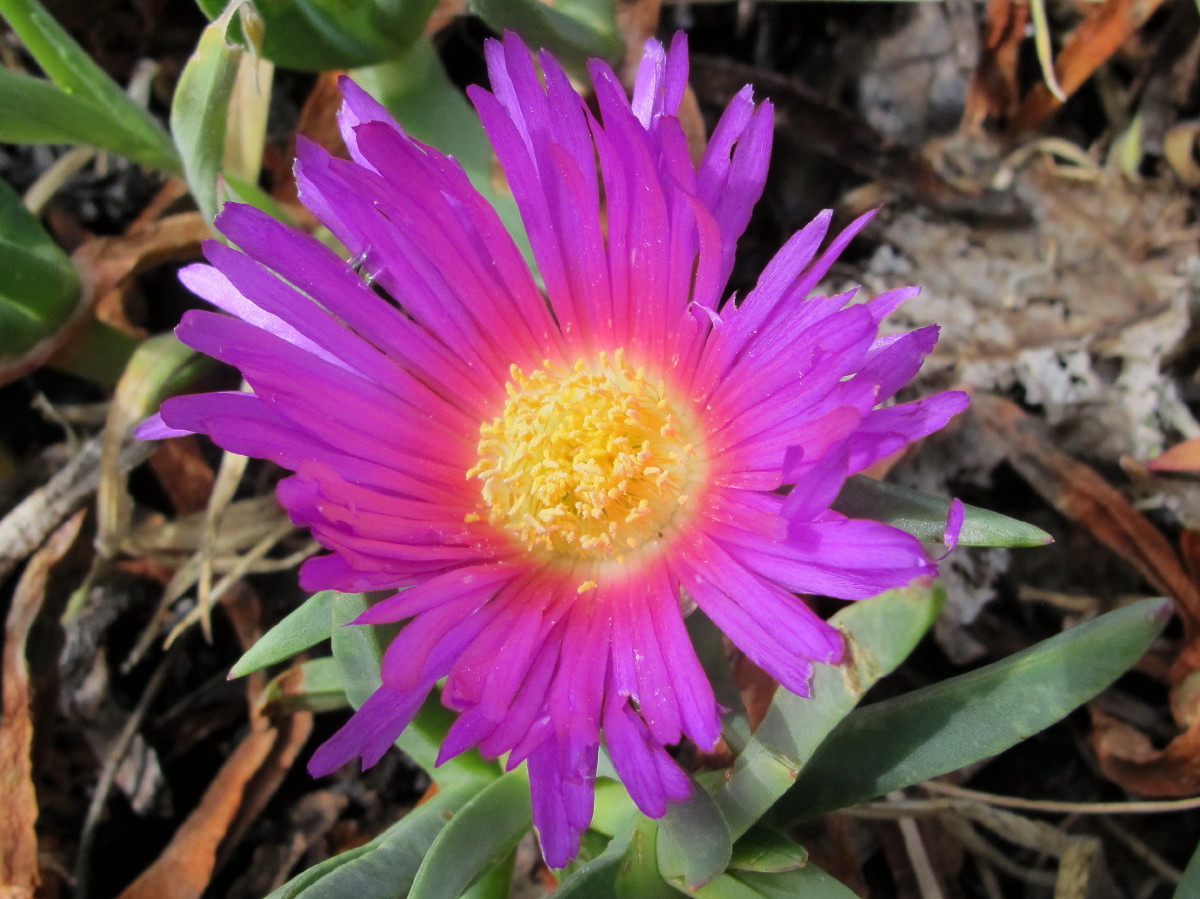
Botanical Name: Carpobrotus rossii
Commonly Called: Native pigface, karkalla or simply Pigface
Botanical Family: Aizoaceae
Grows: This succulent foliaged, floriferous, prostrate species is much branched and 1 to 2m wide. It can form roots at the leaf nodes.
Foliage: The bright green, triangular cross-section leaves are 3 to 8cm long with very short stems and their tips are blunt. They are usually deeper than wide at the mid-point and their keels are smooth or crenulate near the base and/or the tip.
Flowers: The solitary, pink/purple, many petalled, 3.5 to 5.5cm diameter flowers grow on short stems within the uppermost pair of leaves at the end of short lateral branches. The 2 triangular, fleshy calyx lobes are 1.0 to 1.5 and up to 2.5cm long, and the 3 smaller lobes have membranous edges which are often dotted brown.
Flowering Season: The flowers appear in winter and continue through spring and summer. They are occasionally seen during the rest of the year.
Fruit: The edible and fleshy fruit is green, reddish or purple and cylindrical-ovoid in shape.
Habitat/distribution: This species typically grows in moist sandy coastal heaths all around the State and the islands. It is also indigenous in WA, SA, Vic, NSW and Qld.
Where found:This species has been recorded in the following areas and locations: Big Punchbowl and Long Point, Tasmanian Land Conservancy Reserve; Freycinet and Schouten Island National Park (NP); Rocky Cape NP; Tarkine area; Bluff River Gorge – Buckland, Hawthorn Drive Maranoa – Kingston, Luther Point to Spring Beach Coastal – Orford, Mortimer Bay Coastal – Sandford and Winifred Curtis Scamander Reserves. It has also been collected from all around the coast of Tasmania, the Bass Strait islands and most if not all of the other coastal islands.
Other notes: This densely bushy, prostrate plant grows best in full sun with good drainage. It is an ideal dune controlling plant. The distinguishing features are the triangular cross section fleshy leaves and the large pink to purple flowers on a prostrate spreading plant.
Chamaescilla corymbosa
Botanical Name: Chamaescilla corymbosa var corymbosa
Commonly Called: Blue stars
Botanical Family: Liliaceae
Grows: This monocotyledon species has tuberous roots 0.5 to 5.7cm long, while the above ground tussock grows 10 to 15cm high by 10 to 20cm wide.
Foliage: The 2 to 6 linear leaves are 5 to 15cm long by 1.5 to 5cm wide with hairy margins and tapering to a point. They grow in a basal tuft that dies off in summer.
Flowers: The inflorescence has 1 to 6 stems of blue flowers on stalks up to 25cm long, with 6 rounded, 6 to 11mm long, broadly-elliptical petals. The flowers twist on their stems as they die.
Flowering Season: The flowers appear in spring.
Fruit: The fruit is a 3 lobed capsule, up to 8mm long by 8mm wide, the lobes pinnately nerved at maturity
Habitat/distribution: This species typically grows in moist sand in peaty heaths or light forest from sea level to 200m in the north west, north east, midlands and south east of the State. It is also indigenous in WA, SA, Vic and Qld.
Where found: Adventure Bay, Cheltenham Reserve, George Town, Howrah, Northern Midlands, Port Arthur, Rosny Hill.
Other notes: This pretty small tufting plant may be grown in moist, well drained, part sun areas. However, apparently it is short lived in cultivation. This is the only Chamaescilla species in Tasmania.
Chrysocephalum apiculatum
Botanical Name: Chrysocephalum apiculatum
Commonly Called: Common everlasting
Botanical Family: Asteraceae
Grows: Several forms are in propagation, densely prostrate with upright flower stems, rampant spreading with long upright stems and the indigenous form which grows 10 to 50cm high by 20 to 30cm wide, usually as an open small shrub.
Foliage: The leaves are variable, 1 to 7cm long, ending in short fine point. They are grey-green and densely hairy on the upper surface They may have an even denser undersurface. The white stems are woolly hairy.
Flowers: Small, terminal, globular clusters of golden flowerheads on slender stalks to 30cm long.
Flowering Season: Flowers appear in early spring through summer and sporadic in other months.
Habitat/distribution: Widespread in grasslands and along roadsides. It also grows in WA, SA, Vic, NSW and Q.
Where found: Throughout Tasmania, especially dry sclerophyll areas in many National Parks and city bushland parks and gardens.
Other notes: This is a hardy, long flowering, spreading and colourful plant for any garden. It may self seeds or layers in mulch. Prune after flowering for shape and size and to promote more flowers.
Clematis aristata
Botanical Name: Clematis aristata
Commonly Called: Mountain clematis
Botanical Family: Ranunclaceae
Grows: This strong, dioecious, climbing vine clambers on and over other plants or structures from less than 1m to over 10m high and may spread up to 15m.
Foliage: The glabrous main stem, up to 20mm diameter, is very strong. The ternate leaves, with petioles and petiolules often acting as tendrils, have ovate to deltate leaflets, 2.5 to 9.5cm long by 1 to 5cm wide with serrated or occasionally entire edges and are usually glabrous.
Flowers: The flowers grow in numerous axillary panicles with 4 oblong to narrow-ovate, 11 to 28mm long creamy-white tepals. The flower’s pubescent outer surface is often densely white-tomentose at the edges. The stamens are 4 to 15mm long with 1.5 to 4.0mm long linear-oblong anthers, each with a 1 to 3mm long subulate appendage, and staminodes are present.
Flowering Season: The flowers appear in spring.
Fruit: The fluffy fruit, appearing in summer, are 4 to 7mm long by 2.0 to 3.5mm wide brown, ovate and compressed achenes. They are shortly pubescent or rarely glabrous, smooth with edges slightly thickened with a 5cm long awn.
Habitat/distribution: Widespread in open, dry sclerophyll forest but mainly in wetter montane forests. It is also indigenous in SA, Vic, NSW and Q.
Where found: This species is found throughout Tasmania, especially wet montane forest areas: Narawntapu, Cradle Mountain Lake St Claire, Freycinet inc. Schouten Island, Hartz Mountain, Mount Field, Rocky Cape and Tasman National Parks; many city bushland parks and gardens; Bluff River Gorge, Bridport Wildflower, Cambridge Street, Carr Villa, Cataract Gorge, Cheltenham, Diprose Lagoon, Echo Sugarloaf, Knocklofty, Liawenee & Augusta and Ada Lakes, Meehan Ranges, Mount Read, North West Coast from Blythe Head to Lillico Beach, Old Convict Road & Luther Point to Spring Beach Track & Spring Bay Quarry & Three Thumbs Orford, Peter Murrell, Punch Bowl, St Helens Conservation Area, Tarkine area, Tom Gibson, Township Lagoon, Tulla, Upper Mersey & Forth, Western Explorer and Winifred Curtis, and many other Reserves.
Other notes: This beautiful climbing vine species may be propagated from fresh seed and cuttings. The juvenile leaves tend to be purplish in colour. Its fluffy seed heads are a distinguishing feature for the female plants. It is hardy in most soils and prefers a sunny or semi-shade position. It may be heavily pruned and while being a vigorous climber, it tends not to smother other plants.
Comesperma volubile
Botanical Name: Comesperma volubile
Commonly Called: Blue lovecreeper
Botanical Family: Polygalaceae
Grows: This pretty creeper or climber clambers on and over other plants or structures from less than 1m to over 3m high and may spread similar distances.
Foliage: The small, lanceolate leaves, mostly 4 to 12mm long, are sparsely located along the twining stems. The dead flowers and empty seed pods leave scars on the stems when they are shed.
Flowers: The blue, occasionally white, flowers are small and grow on 2 to 4mm long pedicels in compact, axillary terminal racemes. The wide, obtuse outer sepals are ~2mm long and the clawed inner sepals have a nearly orbicular, spreading blade ~6mm long. The keel petals are blue, lilac or white, cucullate with blunt lateral lobes. The posterior obovate lobes are yellowish.
Flowering Season: The masses of flowers appear in early spring and continue through to early summer.
Fruit: The fruit are wedge shaped capsules.
Habitat/distribution: Widespread in heaths and dry sclerophyll forest. Also WA, SA, Vic, NSW, Q.
Where found: Throughout Tasmania especially dry sclerophyll areas, most lower National Parks and many city bushland parks and gardens; Knocklofty, Peter Murrell, Cheltenham, Tom Gibson and many other Reserves; Meehan Ranges; all along the Mortimer Bay Coastal Track, Sandford; along Wielangta Road; Hylands Road, Murdunna.
Other notes: Difficult to propagate and maintain, possibly due to a symbiotic relationship with another species.
Coprosma quadrifida
Botanical Name: Coprosma quadrifida
Commonly Called: Native currant
Botanical Family: Rubiaceae
Grows: This dioecious species of prickly, small to medium bushes, grows typically 2 to 4m high by 1.5 to 3m wide. However, in heavily animal browsed areas it may only grow to 100 to 200mm high and spread 0.5 to 1m.
Foliage: The slender branches are usually pubescent. The lateral ones are divaricate and often distichous and ending in fine spines. The numerous small, thin, opposite leaves, are variable, often ovate-lanceolate 4 to 12mm long, sometimes narrow elliptical-lanceolate 20 to 25mm long. They are glabrous or puberulent, have a short stem and the apex is acute or blunt and apiculate.
Flowers: The solitary, terminal flowers grow on very short reddish stems bearing one or more pairs of stipules and, immediately below the calyx of the flower, an unequal 4 lobed reddish cupule formed from 2 bracts which are fused with the some of the stipules. The female flower’s 4 to 5mm diameter corolla has 4 spreading and recurved cream/pink/white petals and two or three 8 to 10mm long white stigmas. The male flowers 5 to 6mm diameter corolla’s cream petals are strongly recurved and the 4 stamens are exserted with long fine filaments.
Flowering Season: The flowers appear in spring.
Fruit: The fruit is a shiny, almost translucent orange to red drupe with two hard coated seeds within.
Habitat/distribution: This species grows Widespread throughout Tasmania in damp moist gullies and wet sclerophyll forests from sea level to 750m. Also SA and Vic
Where found: It is found in Cradle Mountain/Lake St Clair, Freycinet, Mt Field, Rocky Cape and Tasman National Parks; kunanyi/Wellington Park and many city bushland parks and gardens; Old Convict Road and Probation Station, Luther to Stapleton Points Coastal Track and Thumbs Reserves around Orford; Knocklofty, Mt Barrow State, Tarkine, Tom Gibson, Township Lagoon and many other Reserves; Meehan Ranges; along the Mortimer Bay Coastal Track, Sandford; along Wielangta Road; Hylands Road, Murdunna.
Other notes: This species is easily grown in moist soils in part/full sun and should be pruned to maintain density and for shape. It may be propagated from seed or cuttings.
E indicates an endemic species and links to the relevant endemic page
- Acacia axillaris Sp E
- Acacia dealbata Sp
- Acacia derwentiana Sp E
- Acacia genistifolia Sp
- Acacia gunnii Sp
- Acacia leprosa Sp
- Acacia melanoxylon Sp
- Acacia mucronata subsp. dependens Sp E
- Acacia mucronata subsp. longifolia Sp
- Acacia mucronata subsp. mucronata Sp E
- Acacia verticillata Sp
- Acrothamnus hookeri Sp
- Ajuga australis Sp
- Almaleea subumbellata Sp
- Alyxia buxifolia Sp
- Amperea xiphoclada Sp
- Anodopetalum biglandulosum Sp E
- Anopterus glandulosus Sp E
- Aotus ericoides Sp
- Aristotelia peduncularis Sp E
- Arthropodium strictum Sp
- Athrotaxis cupressoides Sp E
- Athrotaxis selaginoides Sp E
- Bauera rubioides Sp
- Bedfordia salicina Sp E
- Billardiera longiflora Sp E
- Blandfordia punicea Sp E
- Boronia citriodora Sp E
- Boronia gunnii E Sp
- Boronia pilosa Sp
- Bossiaea cinerea Sp
- Bossiaea riparia Sp
- Brachyscome spathulata Sp
- Bulbine glauca Sp
- Calytrix tetragona Sp
- Carpobrotus rossii Sp
- Chamaescilla corymbosa Sp
- Chrysocephalum apiculatum Sp
- Clematis aristata Sp
- Comesperma volubile Sp
- Coprosma quadrifida Sp
- Cyathodes glauca Sp E
- Daviesia latifolia Sp
- Daviesia sejugata Sp
- Diplarrena moraea Sp
- Dodonea filiformis Sp E
- Epacris acuminata Sp E
- Epacris impressa Sp
- Epacris virgata Sp E
- Eucalyptus risdonii Sp E
- Eucalyptus delegatensis subsp. tasmaniensis Sp E
- Eucalyptus tenuiramis Sp E
- Eucalyptus vernicosa Sp E
- Euryomyrtus ramosissima Sp
- Exocarpos strictus Sp
- Goodenia elongata Sp
- Goodenia lanata Sp
- Goodenia ovata Sp
- Goodia lotifolia Sp
- hakea-epiglottis subsp. epiglottis Sp E
- Hakea lissosperma Sp
- Hardenbergia violacea Sp
- Hibbertia appressa Sp
- Hibbertia procumbens Sp
- Hibbertia riparia Sp
- Hibbertia sericea var sericea Sp
- Indigofera australis Sp
- Kennedia prostrata Sp
- Kunzea ambigua Sp
- Lasiopetalum micranthum Sp E
- Leptecophylla parvifolia Sp E
- Leptospermum nitidum Sp E
- Lissanthe strigosa Sp
- Melaleuca pustulata Sp E
- Melaleuca virens Sp E
- Milligania densiflora Sp E
- Odixia achlaena Sp E
- Olearia archeri Sp E
- Olearia phlogopappa Sp
- Orites acicularis Sp E
- Orites revolutus Sp E
- Oxylobium ellipticum Sp
- Ozothamnus scutellifolius Sp E
- Patersonia fragilis Sp
- Phebalium daviesii Sp E
- Philotheca virgata Sp
- Pimelea drupacea Sp
- Pimelea nivea Sp E
- Pimelea sericea Sp E
- Pomaderris pilifera subsp. talpicutica Sp E
- Richea pandanifolia Sp E
- Spyridium obovatum var. obovatum Sp E
- Spyridium obovatum var. velutinum Sp E
- Spyridium ulicinum Sp E
- Stackhousia monogyna Sp
- Stylidium graminifolium Sp
- Tetratheca gunnii Sp E
- Thelionema caespitosum Sp
- Trochocarpa thymifolia Sp E
- Veronica formosa E Sp
- Vittadinia muelleri Sp
- Westringia angustifolia Sp E
- Westringia brevifolia Sp E
- Westringia rubiifolia Sp E
- Zieria arborescens Sp
- Australian bugle Sp
- Beaked needlebush Sp E
- Blackwood Sp
- Blue lovecreeper Sp
- Blue stars Sp
- Bluish bulbine-lily Sp
- Blunt caterpillar wattle Sp E
- Broom spurge Sp
- Bushmans bootlace Sp E
- Button-leaf everlastingbush Sp E
- Central lemon boronia Sp E
- Cheeseberry Sp E
- Cherry riceflower Sp
- Chocolate lily Sp
- Christmas bells Sp E
- Claspleaf heath Sp E
- Common Everlasting Sp
- Common fringemyrtle Sp
- Common heath Sp
- Common speedwell bush Sp E
- Davies waxflower Sp E
- Derwent wattle Sp E
- Dusty daisybush Sp
- Erect caterpillar wattle Sp
- Erect guineaflower Sp
- Fineleaf hopbush Sp E
- Forest candles Sp
- Golden everlastingbush Sp E
- Golden pea Sp
- Golden shaggypea Sp
- Gumtopped stringybark Sp E
- Heartberry Sp E
- Hairy boronia Sp
- Hop bitterpea Sp
- Hop native-primrose Sp
- Horizontal Sp E
- Huon pine Sp E
- King Billy pine Sp E
- Lanceleaf daisybush Sp E
- Lanky native-primrose Sp
- Leafless bossia Sp
- Leafy spiky bitterpea Sp
- Longleaf caterpillar wattle Sp
- Midlands wattle Sp E
- Moleskin dogwood Sp E
- Mountain beardheath Sp
- Mountain clematis Sp
- Mountain pinkberry Sp E
- Mountain riceflower Sp E
- Narrowleaf triggerplant Sp
- Narrowleaf westringia Sp E
- Native currant Sp
- Native indigo Sp
- Native pigface Sp
- Peachberry heath Sp
- Pearly native-cherry Sp
- Prickly moses Sp
- Pandani Sp E
- Pencil pine Sp E
- Ploughshare wattle Sp
- Pretty heath Sp E
- Prickly bottlebrush Sp E
- Prickly moses Sp
- Purple appleberry Sp E
- Purple coral-pea Sp
- Revolute orites Sp E
- Risdon peppermint Sp E
- River boronia Sp E
- Rosy heathmyrtle Sp
- Running postman Sp
- Seabox Sp
- Scented dustymiller Sp E
- Shiny teatree Sp E
- Shortleaf westringia Sp E
- Short purpleflag Sp
- Showy bossia Sp
- Shy pinkbells Sp E
- Silky guineaflower Sp
- Silky milligania Sp E
- Silver peppermint Sp E
- Silver wattle Sp
- Smooth dustymiller Sp E
- Smooth goldentip Sp
- Southern guineaflower Sp
- Spoonleaf daisy Sp
- Spreading guineaflower Sp
- Spreading wattle Sp
- Sticky westringia Sp E
- Stinkwood Sp
- Tasmanian blanketleaf Sp E
- Tasmanian laurel Sp E
- Tasmanian velvetbush Sp E
- Thymeleaf purpleberry Sp E
- Trailing native-primrose Sp
- Tufted lily Sp
- Twiggy waxflower Sp
- Urn gum Sp E
- Varnish wattle Sp
- Velvet dustymiller Sp E
- Warty paperbark Sp E
- White flag-iris Sp
- White kunzea Sp
- Wiry bauera Sp
- Wiry bushpea Sp
- Yellow orites Sp E


